P&O S.S. Himalaya 1949 to 1974
Please Note: Firefox and some other Search Engines may not be suitable
Use Google Chrome for this Web Page to load perfectly!
Please Note: All ssMaritime and other related maritime sites are 100% non-commercial and privately owned, thus ssmaritime is NOT associated with any shipping company or any other organisation! Although the author has worked and been involved in the passenger shipping industry for well over 60 years, but due to his old age and poor health, he was forced to retire. Yet, he has completed well over 1,435 Classic Liners, Passenger-Cargo Liners as well as humble converted C3 converted Migrant Liners, which has transported countless thousands of folk to the new world, as well on vacations’. I trust the features online will continue to provide Classic Liner and Ship enthusiasts both the information they are seeking, but more so provide a great deal of pleasure and relive many happy memories!
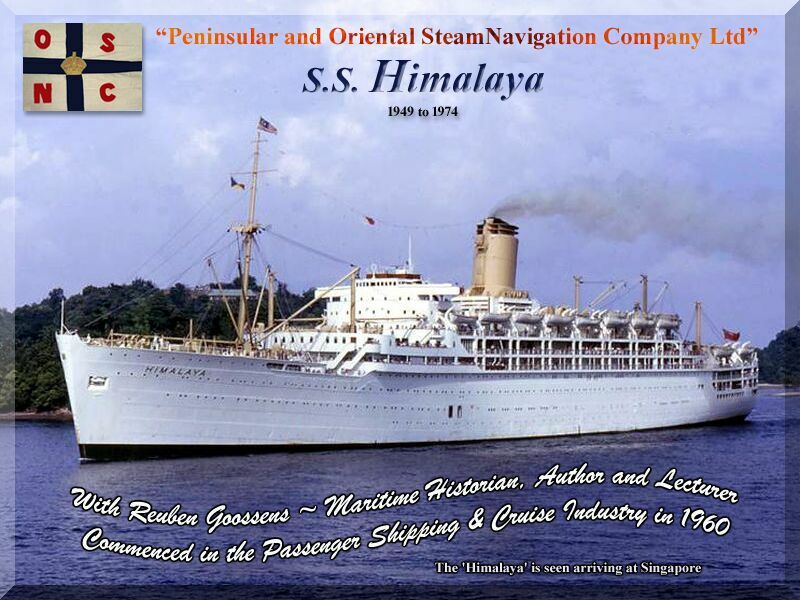
Please Note: Postcards, photographs & other images are either from the author’s private collection, unless stated otherwise.
A
special thank you to the ssmaritime supporters for their very kind assistance.
Page One
This feature covering the S.S. Himalaya (3) is a Two Page feature, as this page covers her entire history as well as a tour of her interiors and exteriors. Whilst page two contains her Deck Plans, Menus, Souvenirs & Memorabilia as well as her ‘Specifications & Details’.
Also, I wish to make it known that I actually wrote most of this feature around 12 years ago, but somehow forgot about it and lost it until someway I discovered it recently. Although I am extremely ill these days and no longer work or write any more, I decided to slowly try and complete it, with the help of a dear friend of mine who will edit it as I am disabled, and can only do so much these days. Thus, this is in fact the very last ever ship that will be added to my site and although it states above that I have written well over 1,435 Classic Liners, that number was a very long time ago, and there will at least around another 500 or so been added by then, give or take.
I hope you will enjoy the S.S. Himalaya story, for I loved her as she was such a fine ship in every respect!
Enjoy!
Reuben Goossens.
***********************
When the World War Two ended sadly P&O had suffered some of the worst losses possible as they had lost some 182 vessels with an amazing loss of around ‘one and a quarter million’ tons, which was almost unbelievable!
Thus a rebuilding schedule of their passenger
fleet commenced rapidly in 1945; when P&O ordered their new liner the
The Three S.S. Himalaya’s
The S.S. Himalaya of 1949 would be the third
ship to bear the proud name of ‘Himalaya’, and these ships were
given a name that matched their greatness for P&O at the time, for all
three were named after the
S.S. Himalaya (1):
The first “Himalaya” was Barque-rigged steamer completed built in 1853 and she was 3,553 tons, and was intended to be used on Orient service, however, the Crimean War changed this and she was used by the British Admiralty. Thereafter she was sold and became a ‘coal hulk’.
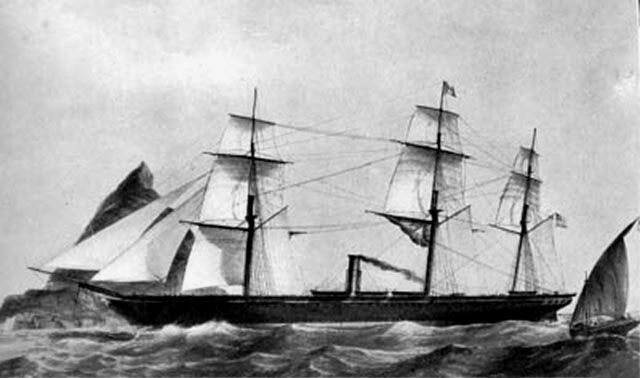
“
S.S. Himalaya (2):
The second S.S. Himalaya was built in 1892 and she was 6,929 GRT GRT (Gross Registered Ton) and 465.6 ft long. She accommodated 265 First Class and 144 Second Class passengers, and had a crew of 249.

S.S. Himalaya (2) of 1892 was a good looking ship
She was built for the Tilbury to
***********************
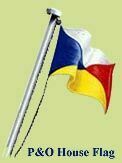
S.S. Himalaya (3):
In 1945 P&O ordered their first new passenger liner of the post-war period. This new liner when it emerged in 1949 certainly was not just a splendid ship, but being 27,955 GRT and a 708.8 ft long sailing at a service speed of 22 knots ship, she was also the largest and fastest ship that P&O had ever owned up until that time..
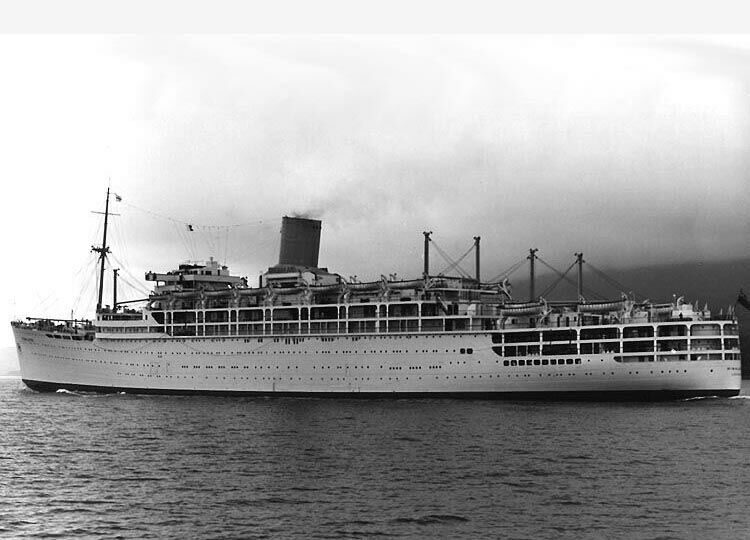
S.S. Himalaya is seen as built in 1949
Design & Construction:
She was ordered in March 1945 and she was built by Vickers Armstrong Ltd’, at Barrow and her keel was laid in Yard number 951 on February 26, 1946. Her building took some 18 months longer than was planned, and at £3.4 million, she was £1 million over budget when she was finally delivered.
The big day of her launching came and she was
launched by Lady Curry, the wife of the P&O Chairman, on 5th October 5,
1948. What many did not know is that the “
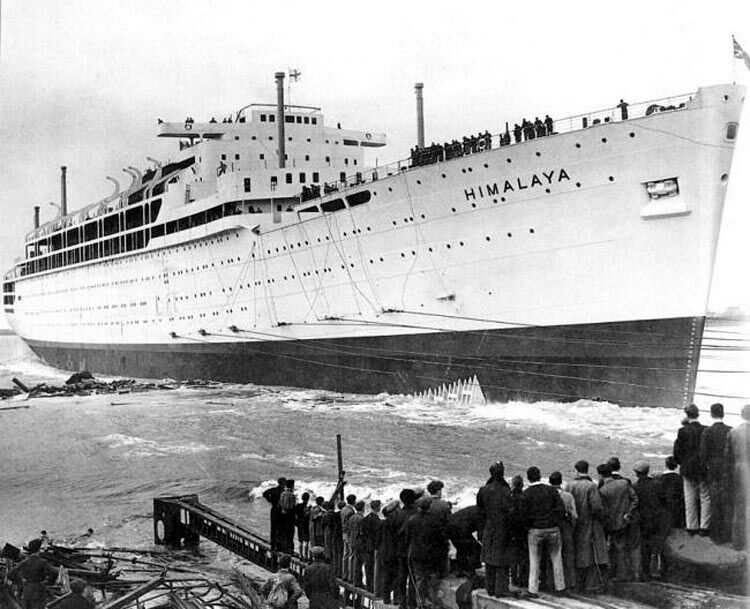
Having been
launched the “
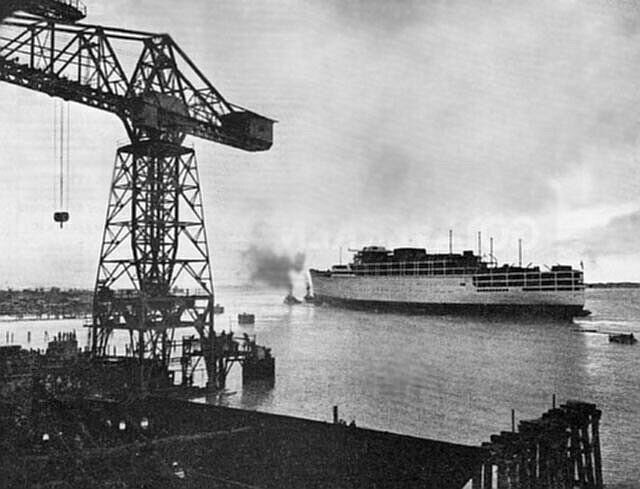
She is seen under tow to her fit-out berth
As she entered the water she was taken in tow and she headed to her fit out berth and as she was getting close to completion she was joined by her smaller sister the Chusan which was berthed aft of her for her fit-out.
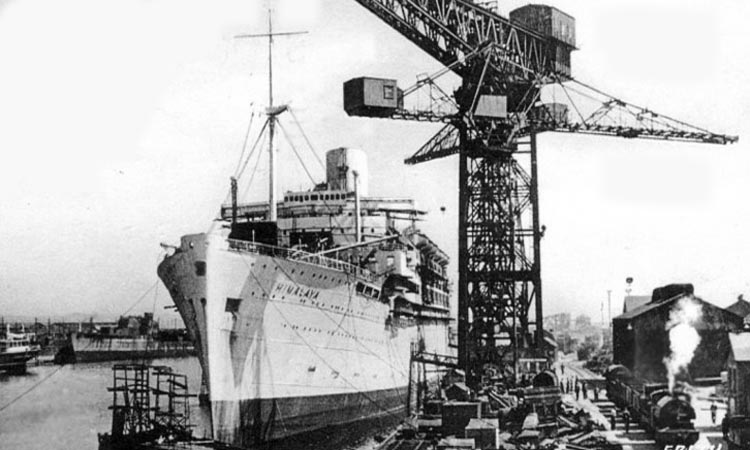
S.S. Himalaya is seen
at her fit-out berth
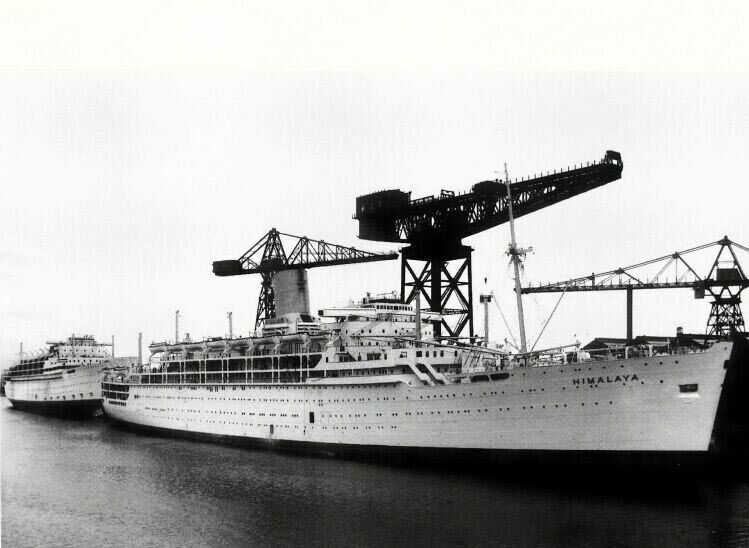
Here we see that the Chusan has arrived on June 28, 1949 and is berthed aft of the
almost completed “
With the “Himalaya” ready, she departed for her speed trials off the Isle of Arran on August 24, 1949, and she achieved a speed of 25.13 knots over the ‘measured mile’.
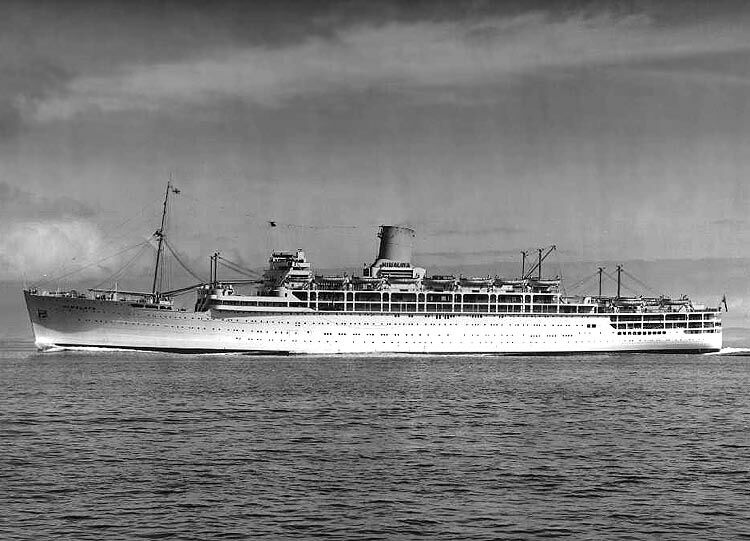
S.S. Himalaya is
seen during her measured mile speed trial
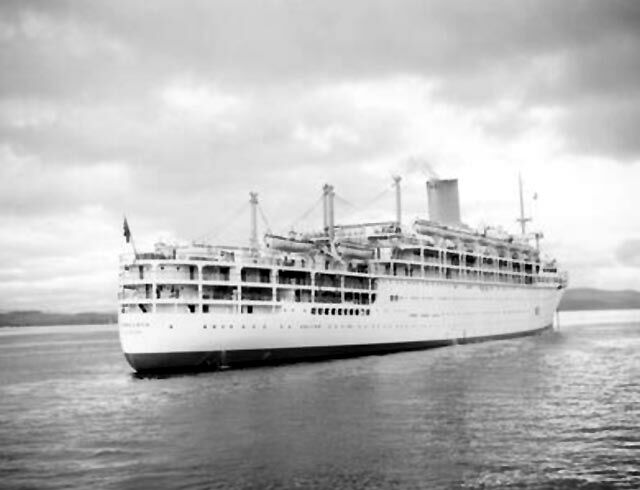
Another photo of her during her trials
Although after her trial she was officially
handed over to P&O on September 1, 1949 at Tilbury, but she did return to
Some Ship’s Information:
She was an all-white ship, with a hull and superstructure, and red boot topping at the waterline, her funnel, masts and derricks, etc, were all buff to yellow. Her Gross Tonnage was 27,955 GRT, and she had a length of 708.8 ft. She was powered by a set of double reduction geared steam turbines by her builders, which developed 42,500 SHP and steam was supplied at 525psi, and 850°F by four controlled superheat ‘Foster Wheeler’ boilers. Four turbo-generators supplied electrical power for heating and lighting throughout the ship and there were two emergency diesel generators. Her twin screws had her sail at a service speed of 22 knots, although during her speed trials she managed to achieve an excellent 25.13 knots maximum.
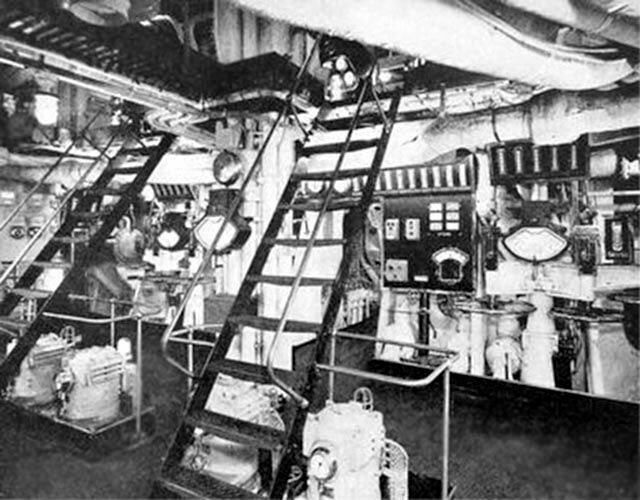
Above &
below: A view of the Engine Room Control platform
and one with her engineer
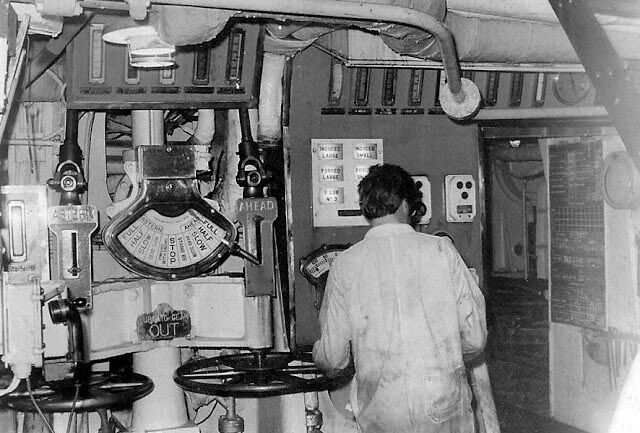
She accommodated 758 First Class, 401 Tourist Class Passengers; but later in her career she became a One Class all Tourist Class ship with 1,416 passengers. She was the first ship to have air-conditioning in her Dinning Rooms and all First Class accommodations. In addition, she would also be the very first liner to be equipped with the innovative “Weir evaporating plant” which distilled sea water into perfectly fresh water.
The “
Her Maiden Voyage:
The “Himalaya” arrived at
Tilbury’s Landing Stage on September 11, 1949, and the commenced to make
her ready for her maiden voyage to
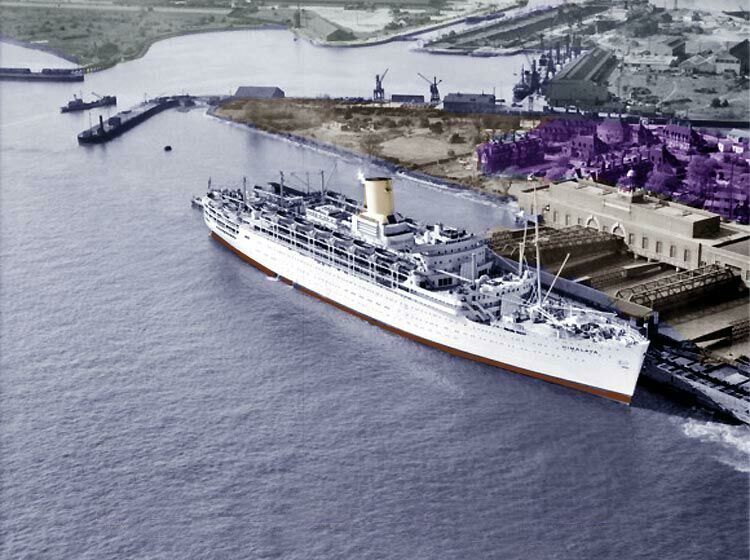
S.S. Himalaya is seen berthed at the Tilbury Landing Stage ready for her big departure
Then the time came for her to be laden with cargo, and with food to be brought on board as well as all the necessary requirements, making sure that by the day the passengers arrived, the ship would be spick and span, beds perfectly made and she would be like home, yet feel very much ready for a fun like vacation awaiting ahead for them!
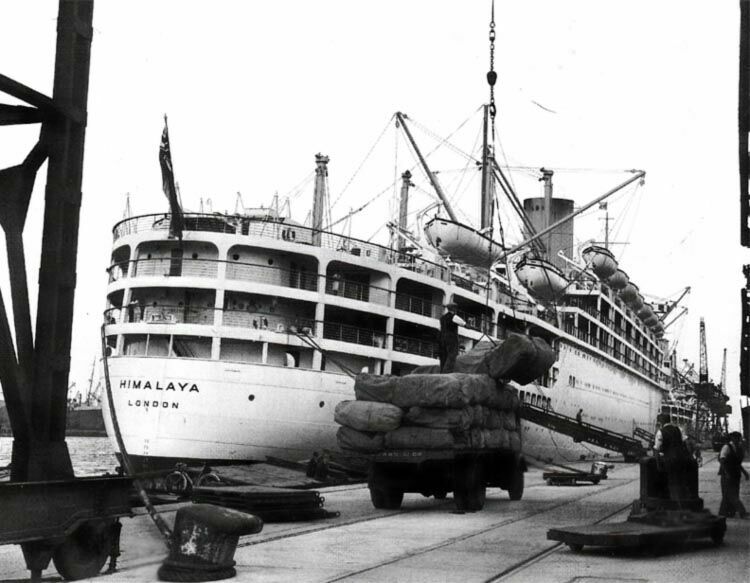
Cargo is seen
being loaded on the “
October 6, 1949 has arrived, as her passengers who had all gone through all the formalities with passports and papers checked and they were now on board, been to their cabins, their family and friends have left the ship and where dockside and a band was now playing. They were certainly ready for their long voyage ahead, yet there was no doubt that emotions were slowly beginning to reach a high note for those on board, but also for many of those ashore. Obviously many would not be seeing each other again for a very long time, as there were those who were migrating to Australia to start a new life there, whilst others who may have been tourists yet they would not be back home for at least six or possibly many more months!
The time came and the S.S. Himalaya slipped
her lines as she slowly departed Tilbury (
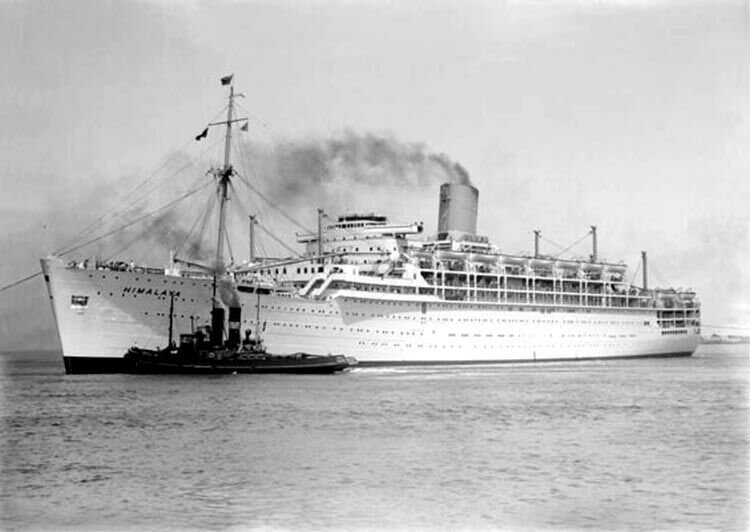
S.S. Himalaya is
seen finally on her way to
Passengers soon got to know their way around
the ship and began to enjoy their surroundings, especially the daily activities
that were available, but as always the highlight was always the great food that
was available in the Dining Rooms, as well as those wonderful Buffets!
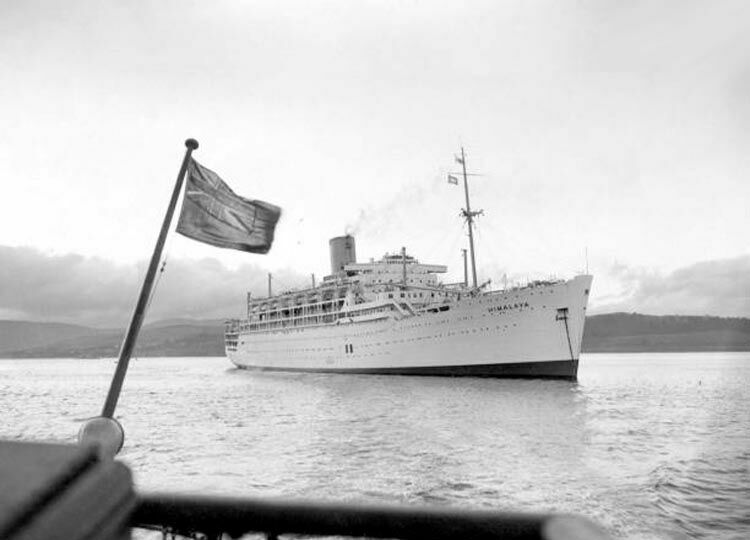
She is seen here
at anchor at
Himalaya certainly proved to be a record
breaker for she cut the
The Himalaya arrived in
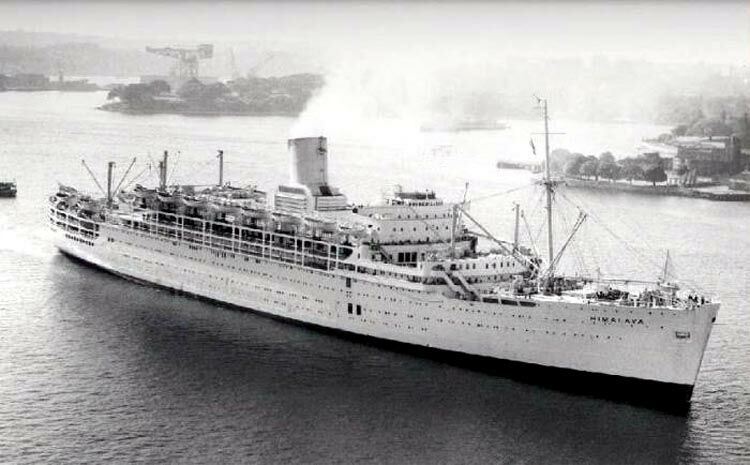
A photo taken from
the
seen arriving at
Note the point with the trees on the right, that is called ‘Bennelong Point’
being the very place
where the ‘Sydney Opera House’ stands today!
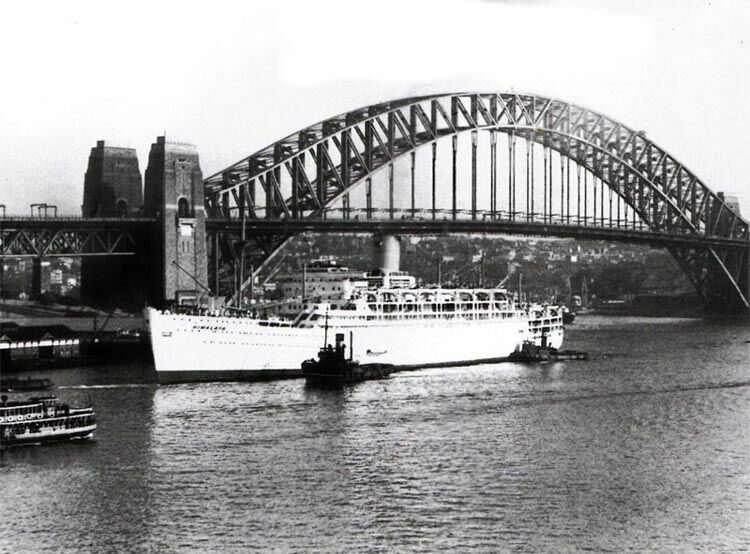
The “
On board on the Foc’sle a special photograph was taken of the entire ships company including P&O’s chairman, Sir William Currie who was on board during this voyage.
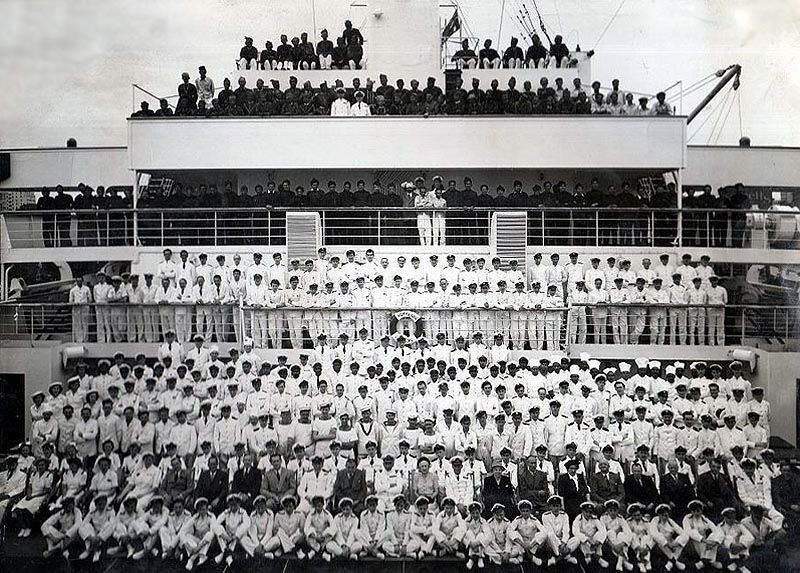
The Captain D.M. Stuart DSC, Sir William Currie and the First Officer
are seen in the centre of the second row from the bottom
The six ships operated by ‘P&O’ and the ‘Orient Lines’ worked closely together on their Australian service, and they had their schedules organised in such a way that sailings alternated between P&O and Orient. Thus they formed, quote: “A Southern Dominions Big Six fleet”.
***********************
Tour of the Ship:
Now the
First Class
The Bridge:
Far forward above Boat Deck there is a there level Bridge section, and topside obviously is the location of the ships Bridge, which is manned 24 hours per day whilst at sea. The Chart Room is located directly aft of the bridge itself.
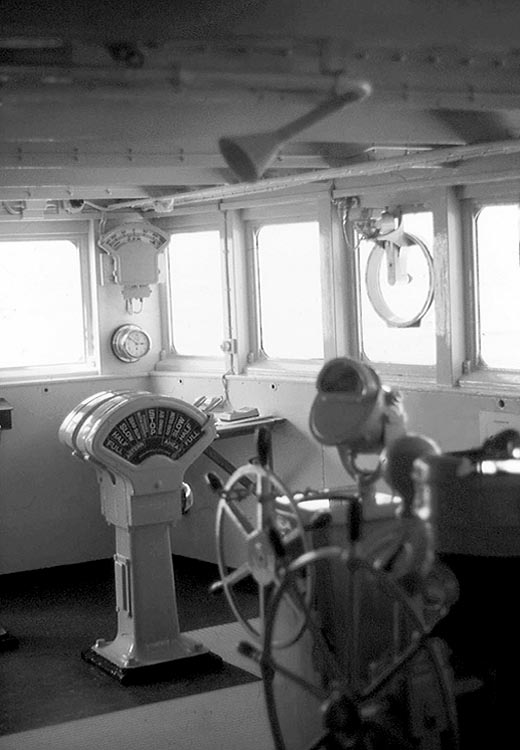
The Bridge seen
whist in port
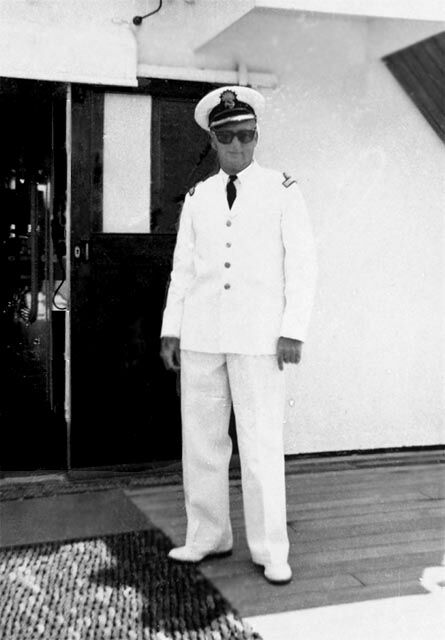
This is Captain Cowen seen on the portside door of the bridge who was in Command of her in 1964
Stairs lead down to the middle level and at the front overlooking the Foc’sle is the Captains office as well as his private quarters, the First Officer’s quarters is also located on this level. There are other senior officers as well as the chief engineer that are accommodated on the lower level and there is also the Radio room.
Boat Deck:
Sports Deck:
This deck offered a very large space for
sports and other activities, whilst directly aft of the Bridge housing was a
very large deck space which was enclosed on both sides by folding glazed
screens, which kept any wind at bay and the warmth of the sun in. The size of
this deck can be gathered from the mere fact that there were nine Deck Tennis
Courts and 28 Quoits Pitches laid out here.
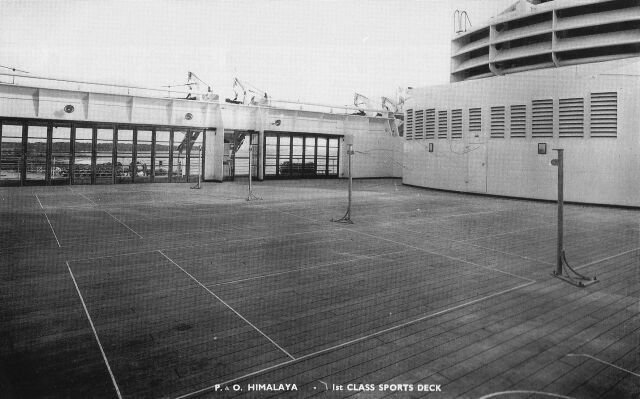
Forward Sports Deck
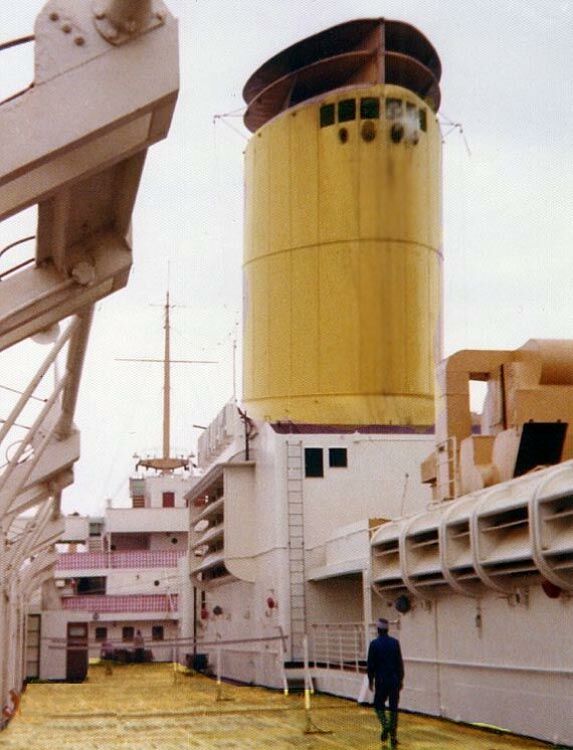
Boat Deck portside looking forward
Promenade Deck:
Children’s Playroom:
The first Passenger facility on Promenade deck is amazingly the Children’s Playroom and on both sides there are spacious safely netted play decks, thus completely safe for the little ones to play at! Everything is here including facilities, and snacks and drinks are provided at the relevant times, etc.
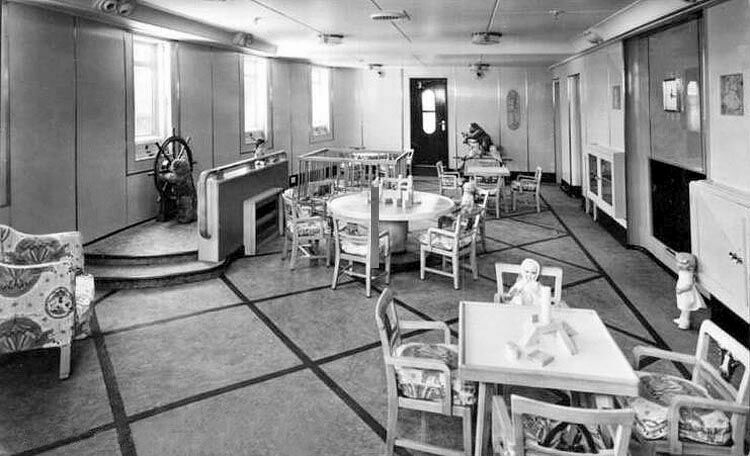
It should be noted that the entrance to this
venue was via a staircase on the starboard side forward on the starboard side
interior.
Lobby side Lounges:
As we head to the main interior of the deck we will start at the forward Lobby which has on both sides two delightful intimate Lounges, which are beautifully decorated and a popular location to chill out.
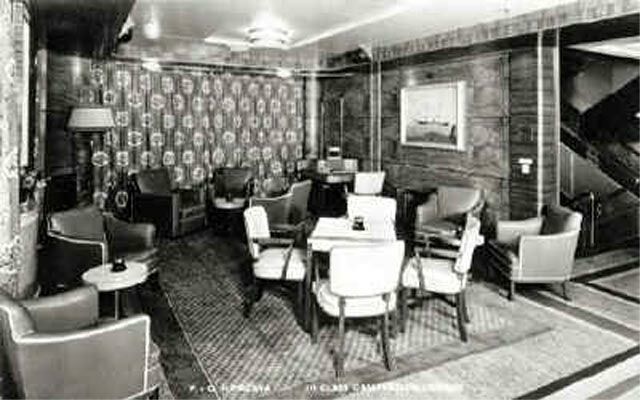
This is the portside of the two Lobby Side Lounges the starboard side is identical
Of course the lobby has Central double Main Staircase which goes up to Boat deck and down to D Deck and the Dining Room. Along the aft bulkhead there are two Elevators (Lifts) as well as some further seating with tables.
Promenade Deck:
On either side of the Lobby there were doors out onto the Promenade Deck, which was a wide fully covered deck and far forward it has a glass enclosed section that covered the entire Ladies lounge and the Lobby and a little more, etc, and along the lounge area the deck was even wider, thus a very spacious deck for guests to enjoy their time out of the weather when it is unpleasant during the winter months, etc.
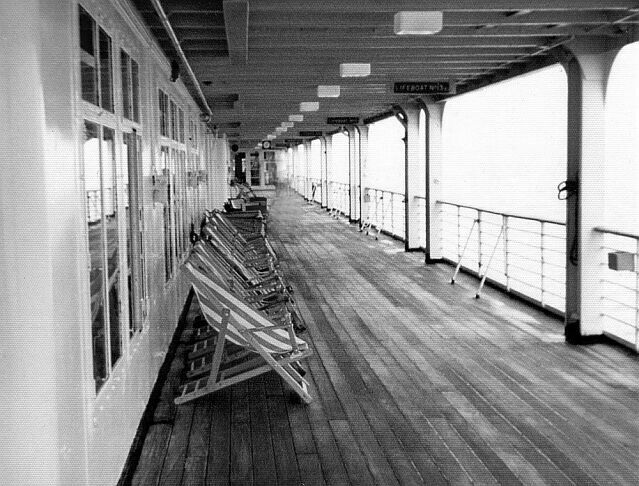
The spacious Promenade Deck (starboard side), note the fully glass enclosed promenade forward
The Lounge:
From the lobby there were double swinging thick glass doors that led into the Main Lounge and the venue featured a host of fine Australian timbers and other touches. The venue was contemporary, yet somehow classic in style, and had that “ever so British” feel
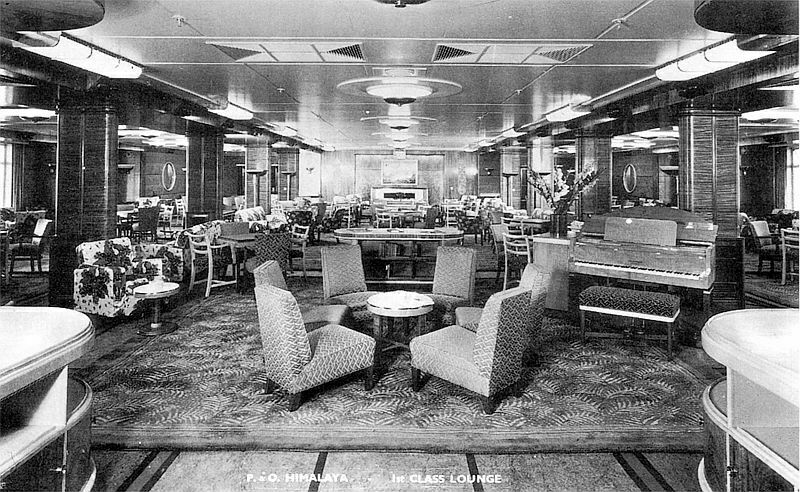
The Lounge, note the Piano
It was said by most guests that you always felt at home as soon as you arrived in this room! Forward on the port side was the bar which was a steward service only bar.
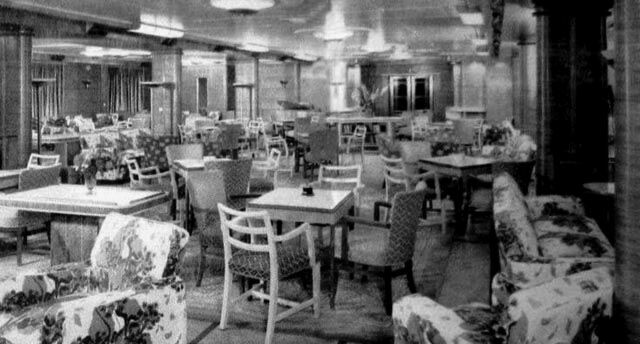
Looking towards the forward central double entrance door of the Lounge
Aft of the room were two doors, one on the Starboard side led to the Library &Writing Room, and the one on the Port Side to the Australia Room.
Australia Room:
Considering at that time P&O had been
associated with
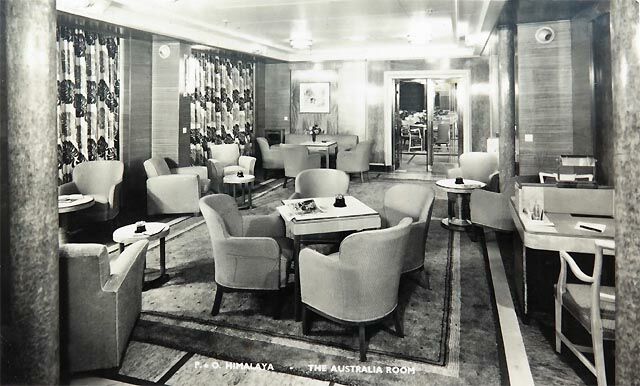
The Australia Room
The Library & Writing Room:
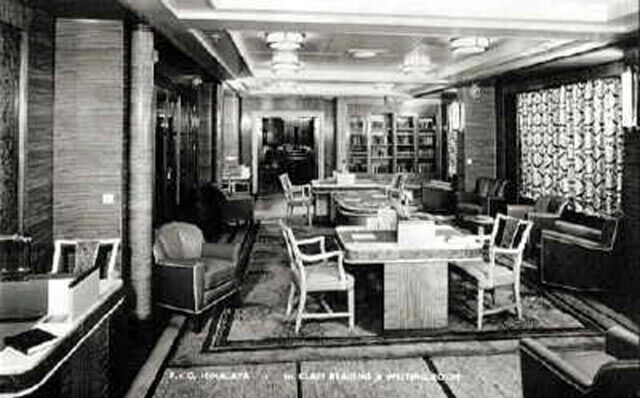
The wonderful Library & Writing room
The books were located in two four glass door cabinets, one on the forward bulkhead, and one on the interior bulkhead.
Aft of both the
The Ballroom:
The venue had a more casual style of furnishings, being mostly the cane style chairs and square laminated topped tables, thus it had a more casual feel, the slightly raised bandstand was located against the forward bulkhead and being the dance venue there was of course a host of multi-coloured concealed lighting.
The Ballroom would also be used as a Cinema and for the ever popular horse races and all the other fun games and entertainments that happen of board these fine ships! And not to forget the special Children’s Parties!
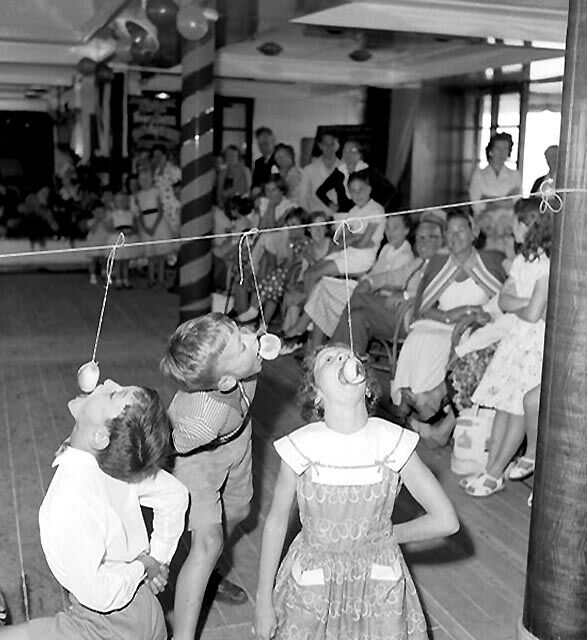
The Ballroom seen
during one of the Children’s parties
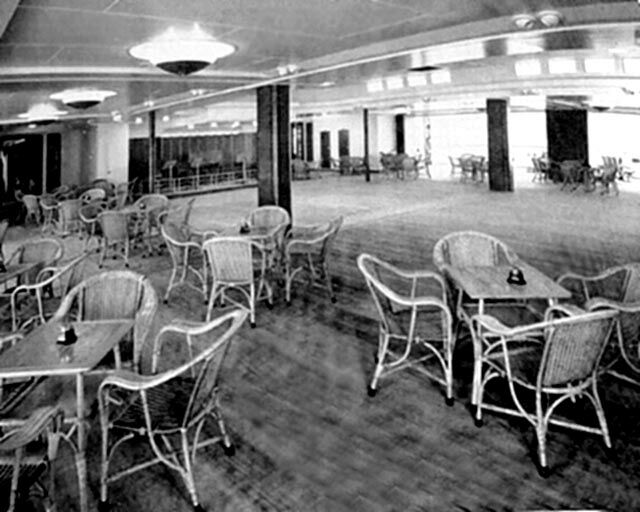
An overall view of the Ballroom
I am sorry for the poor state on this image, but believe me it was in a far worse state when I found it
Forward on the portside there was a pantry for a snack service and on the same side but aft was the Steward only service Bar.
Directly aft of this venue was the last on this Deck and that was the …
Verandah Café:
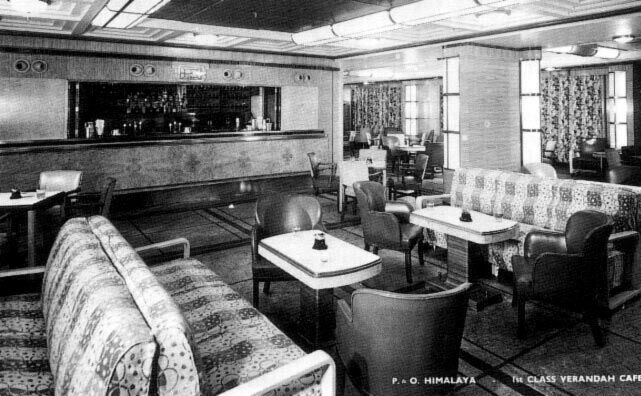
On the centre forward bulkhead was a large Bar
and finally it was one that was accessible to the passengers, thus you could go
to the bar and order a drink, unlike in any of the other venues where drinks
were only available by ordering it from a steward.
A Deck:
This was a deck with mostly cabins, but it also did have a number of important other venues, such as at the forward Lobby along centre aft bulkhead was the spacious ships Shop which had a huge variety of items, from clothing, a host of daily needs, gifts and Souvenirs, and sweets, and so much more.
Directly aft of the Shop with the entrance being on the starboard side hallway were the Ladies Hair and Beauty Saloon and the Men’s Hairdressing Saloon.
Promenade:
At the sides of the Lobby there were the door opened out onto the fully covered promenade deck, although not as wide as the Promenade above, but this deck was a full walk-around deck, thus perfect for those who loved their daily walk a mile or two around the ship.

The A Deck Promenade port side looking forward
The windows seen are those of the Pool Café located far aft on this deck
Pool Café:
The delightful Pool Café a more casual venue
and it was ideal considering it was just forward of the Swimming Pool and
sweeping windows aft provided an overall view of the Pool.
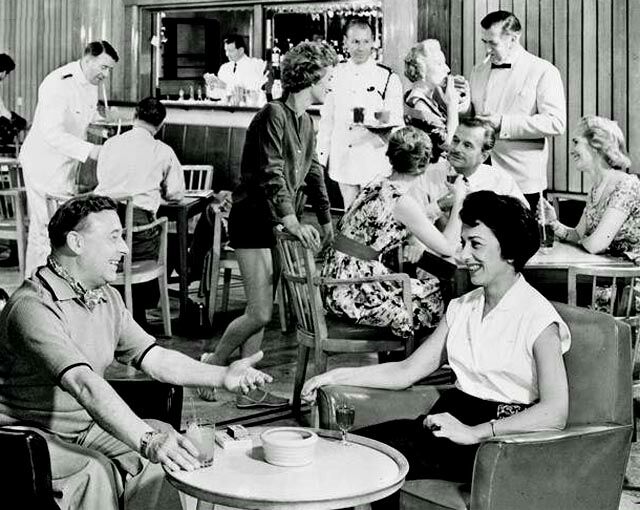
The Pool Cafe
This venue had that outdoor type atmosphere and it was perfect for the setting and although there was a full steward service available, however the Bar was open to the guests to obtain their drinks. Furnishings was in a more casual timber style, with round and square tables with Formica tops, as well as some leather lounge chairs. Two doors on the aft most windowed wall led to the deck and poolside.
The Swimming Pool:
The pool was perfectly sheltered by the surrounding facilities, with the ladies changing rooms and WC’s on the starboard side, and the men’s facilities as well as the Pool attendant room located on the portside.
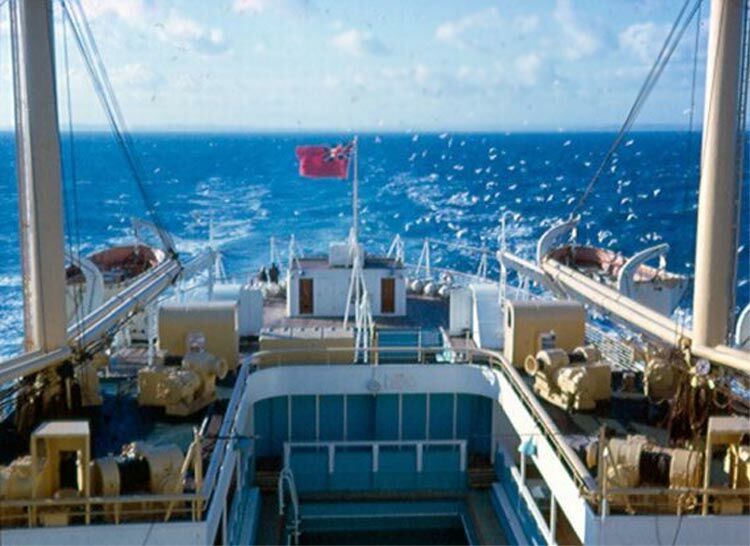
The Swimming pool is seen from Boat Deck above
Accommodations:
The vast majority of outside cabins on this deck had either a bath and WC, with a basin in the cabin, or a shower and a WC, etc. Others would use the many public facilities that were located in countless locations and were always nearby and kept spotless.
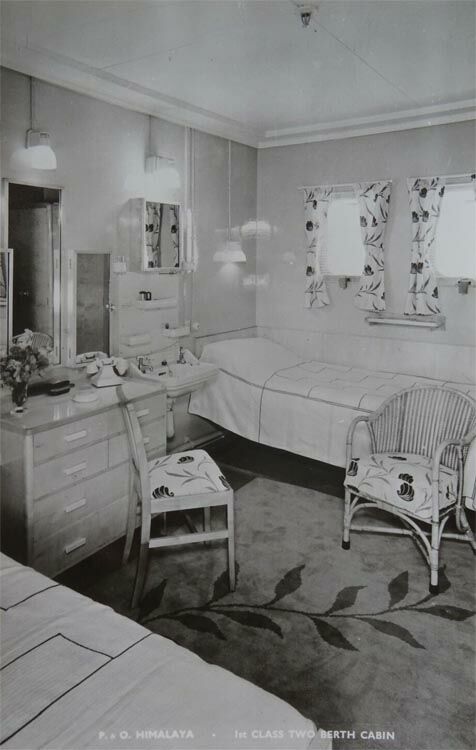
Twin bedded cabin
with a bath & WC

A Single bed cabin with a private shower & WC
B Deck:
However, the two sections can be split and sold as individual Cabin De-Luxe, meaning that One has a spacious bedroom with a sitting space and is identical to the other four Cabins De-Luxe. Whilst the second part of the Suite has also a bedroom when sold separately, but the Verandah is the lounge and it has four large windows. There are also a good number of single and two bedded cabins with either a shower or a bath, etc.
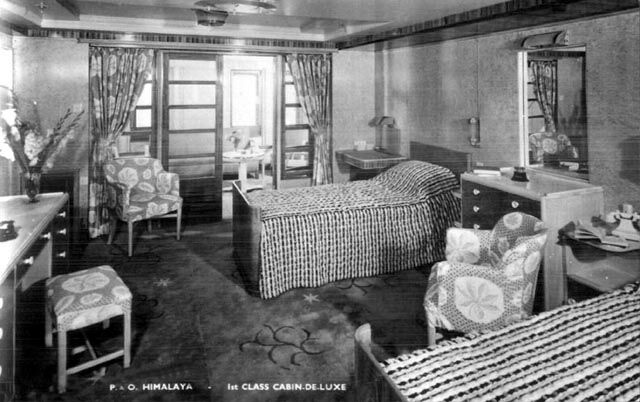
Here we see the Verandah part of the suite, being sold as a Cabin De-Luxe
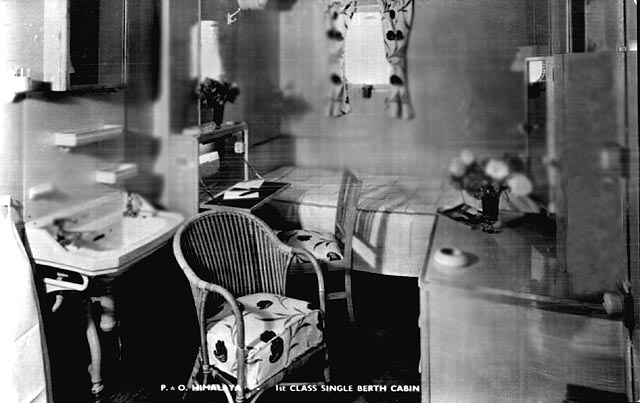

Here we see an inside twin bedded cabin
There is also an ironing room located on this deck. As we head aft of the cabins there is the aft main Lobby with a lift which goes from Promenade Deck down to B deck. Just forward of the Stairwell is the main telephone venue, where passengers can make use of the phone, as there are a good number of phones there. Located aft of the Stairwell and another lobby is the First Class is “Bureau” or as it is better known as the “Pursers Office”, whilst on the starboard side there are a further five offices for the use of the purser and his staff, etc.
C-Deck:
Forward on the portside at the Main Lobby is a Dispensary, where the ships doctor can be seen, whilst far forward on the same side is the ships hospital with a theatre and four wards.
This is a much shorter deck with cabins as it only has cabins until amidships. Located forward they are all two berth cabins that is a cabin with a lower and an upper berth, all having a wash basin, but all with share facilities. The rest of the cabins are either singles or twin bedded, but all are use share facilities.
D Deck:
The heart of this deck is the Lobby which also happens to be the First Class Main Entrance Hall. Directly forward of the Lobby there were just 17 cabins, being either twin bedded or two berth cabins, all using share facilities.
Dining Room:
Whilst directly aft of the Lobby was the only other venue on this deck for First class and that was the Dining Room which was perfectly situated amidships. The venue was in many ways rather understated with soft tones and delightful timbers, but on the central forward bulkhead was a beautiful long mahogany buffet and above it was a stunning large mirror feature which contained a painting of tree branches with birds.
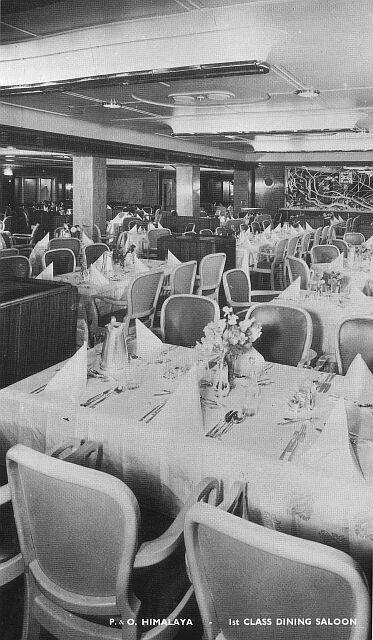
Above &
below: Two views of the Dining Room
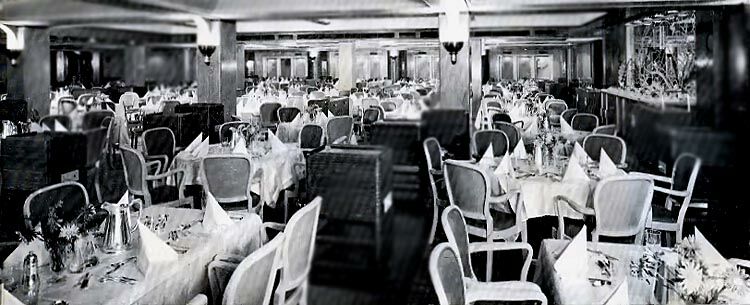
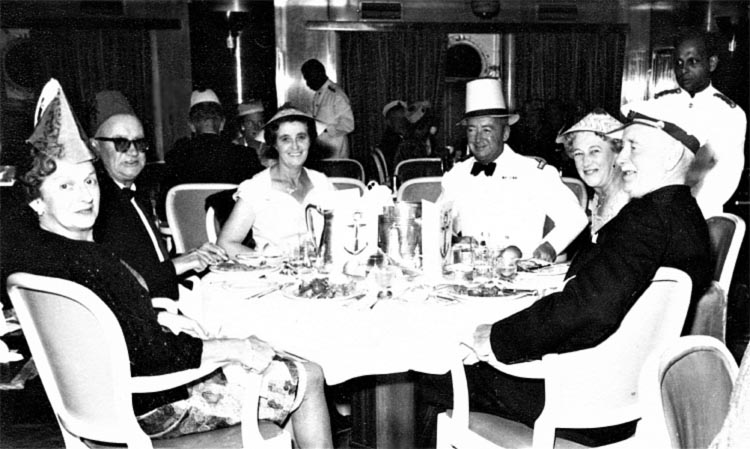
Guests at the Captains table
The Dining Room seated 389 passengers at tables for two, four or six dinners at square or round tables. Strangely, the entrance to the dining room was via one of the two ‘revolving doors’ that were located on the exterior side of the two Elevators (Lifts). Aft on the starboard side of the dining room there was a small private dining room, for special occasions, etc.
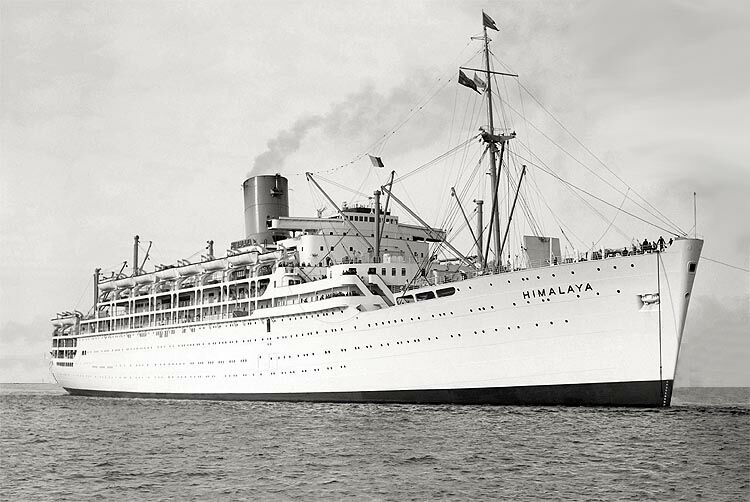
S.S. Himalaya seen
at Port Phillip Bay Melbourne in 1950
******************************
Tourist Class
Tourist Class passengers were accommodated aft of the ship on A to E Decks. And they had every possible facility available to them one would expect on a passenger liner!
A Deck:
This was a wide open and a spacious Sun come Sports and general activity deck, and there was also a Swimming Pool, therefore this was obviously a popular area.
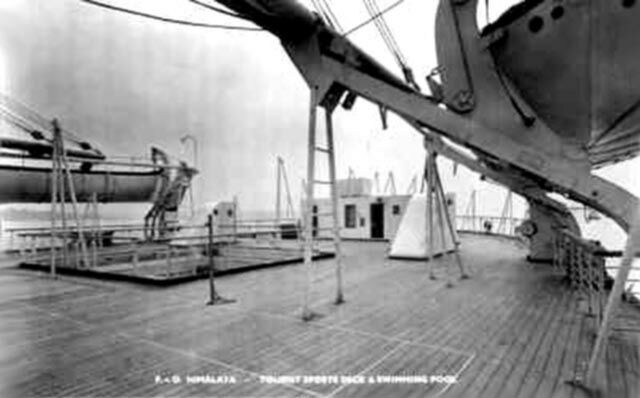
Sports deck and the Swimming Pool
B Deck:
Forward of on this deck for Tourist class was the Bureau (Pursers Office). But directly aft were two venues along the port side was the Dance Hall and on the starboard side the Cinema. Just as up in First Class the sides of the rooms had sliding glass doors that could be either open or shut with.
On the portside aft there was a Bar for steward service only. Outside there was covered promenade space and far aft the ships hospital.
C Deck:
The Tourist Class main stairwell commenced on this Deck and it went down to E Deck. Just aft of the stairs on both sides there were two shops, offering general everyday items and specialty goods and souvenirs, etc.
Smoking Room:
Just aft was the spacious Smoking Room which was a large and a beautifully furnished and finished venue, featuring lighter timbers, and fine works of art and a large mural mover the aft fireplace. The bar was located forward of the venue and was open to the passengers. Along both sides huge windows overlooked the Promenade deck, and provided grand views of the sea during the day.
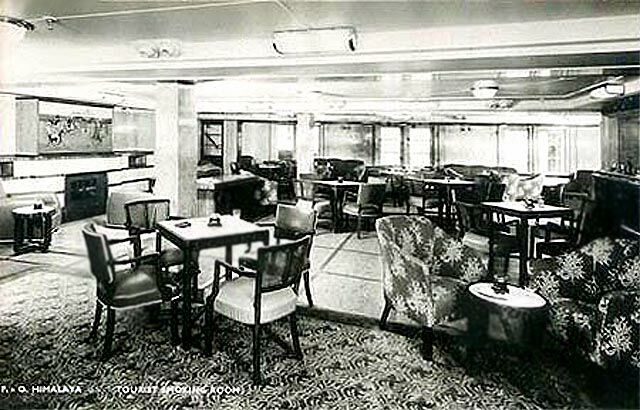
A most hospitable Smoking Room!
Children’s Playroom:
Directly aft of the Smoking Room was the well-equipped Children’s Playroom complete with every possible facility, also their outdoor safe playground.
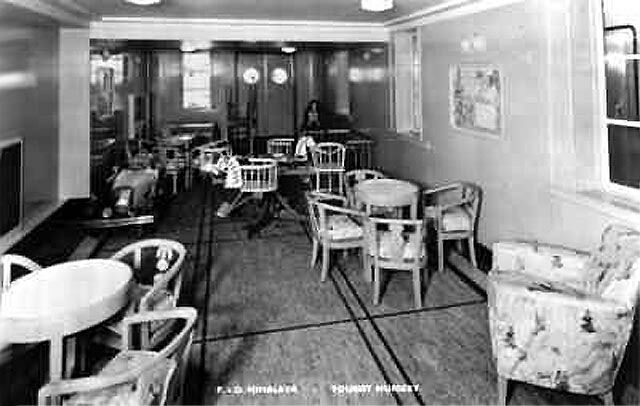
The Children’s Playroom
Aft of the Children’s Playroom, was a separated area for the crew who would be able to relax on that deck area there, often the Goanese crew would go there and enjoy their lunch there.
D Deck:
This Deck had two main Venues, the Dining Room forward and the Lounge aft, and in between these two there were 30 cabins.
Dining Room:
The Dining Room was tastefully fitted out, with maple and mahogany timbers, maple was featured mainly as walls and column trimmings, whilst the walnut was used in all furnishings including the cabinets and the large buffet. The room seated 208 passengers at tables for two, four or eight.
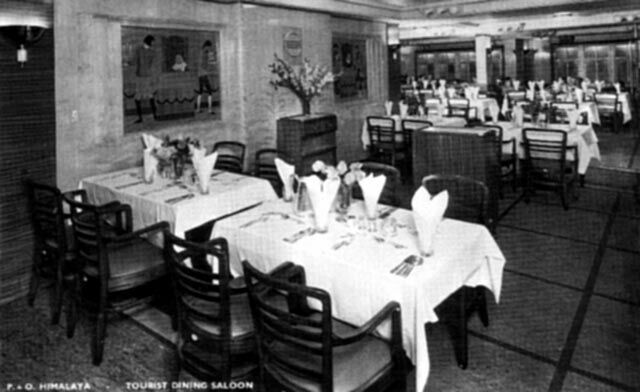
Above &
below: Two views of the Dining Room
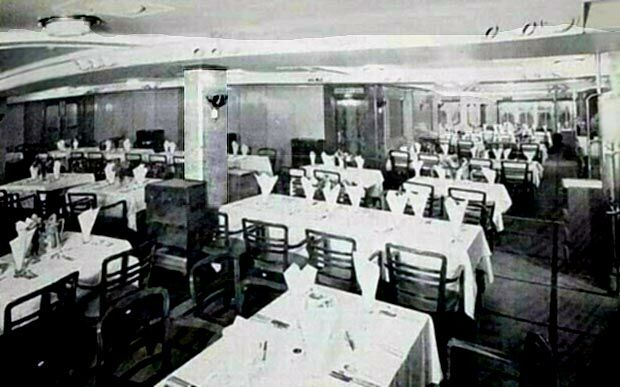
Personally I liked the chairs in this venue much better than those in the First Class dining Room, as those here seemed to be far better suited.
The Lounge:
Like the Dining room it is maple and mahogany that is featured in this delightful venue with its huge bay style windows on both sides. The lounge has that homely feel, and it is a room that was much loved by the passengers!
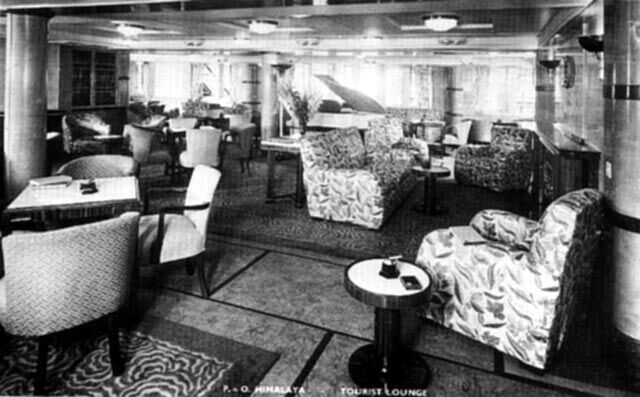
The delightful Lounge
Beside and directly aft of the lounge was a spacious covered promenade deck, which proved to be a popular space. But just further aft of this at the stern interestingly was the ships main laundry.
Accommodations:
Between the Lounge and the Dining Room there were those 30 cabins all these were two berth cabins, certainly not the world largest accommodations, but comfortable, with all having a washbasin with hot and cold water, but of course having to the use of the public facilities.
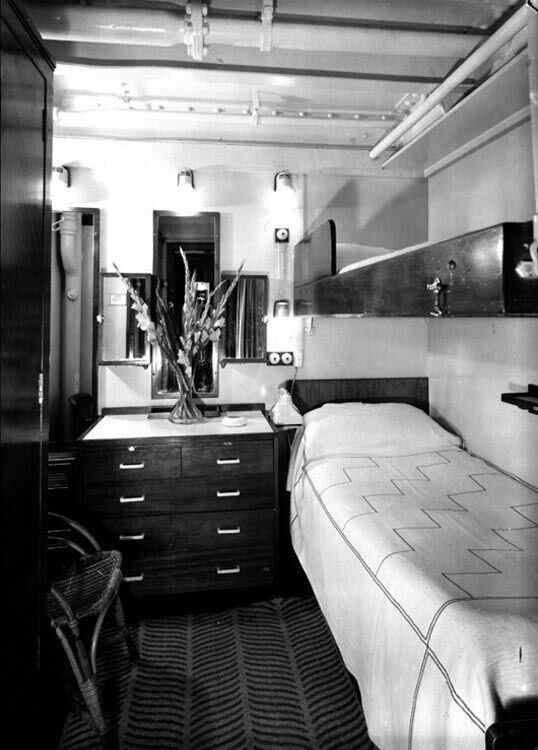
An Inside two berth cabin
E Deck:
This deck has the vast majority of the cabin’s, there is a clump of them that goes as far back as the rear of the Lounge and as far to the forward part of the Dining Room. Then on the port side the Tourist Class cabins continue as far as where just one deck above (C Deck) the aft of the Main Entrance Hall starts.
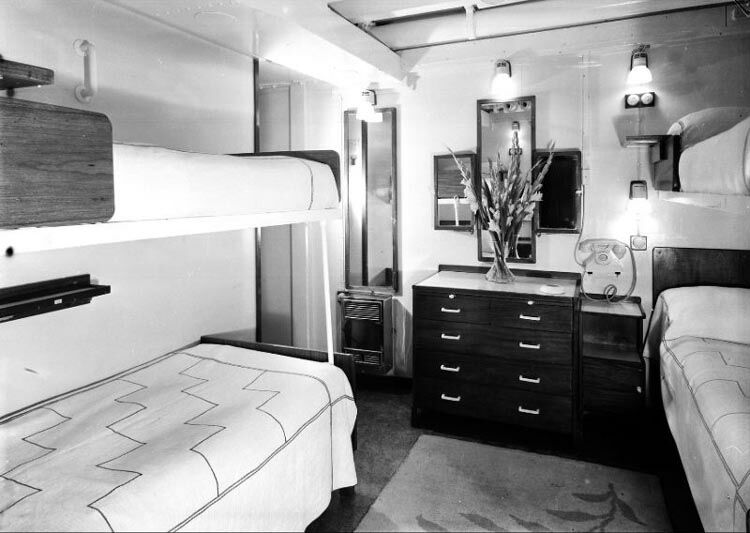
An inside four
berth cabin with a washbasin
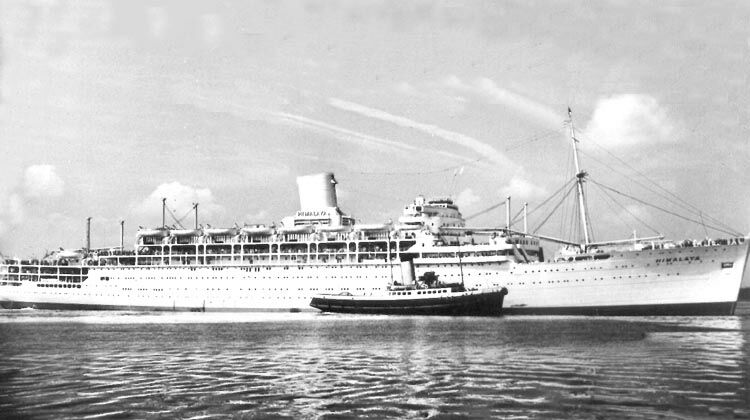
S.S. Himalaya is seen between 1949 and 1952
‘Overseas
Passengers Terminal’ at Circular Quay
******************************
“Thorneycroft Funnel top” fitted 1953:
Both the “
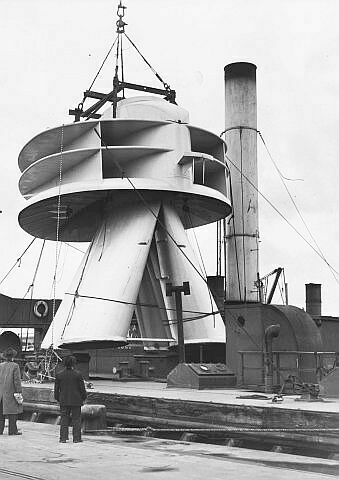
The Thorneycroft’s extension, the bottom part fits inside the funnel
Thus in 1953, the famed Thorneycroft funnel
top extension was added to “
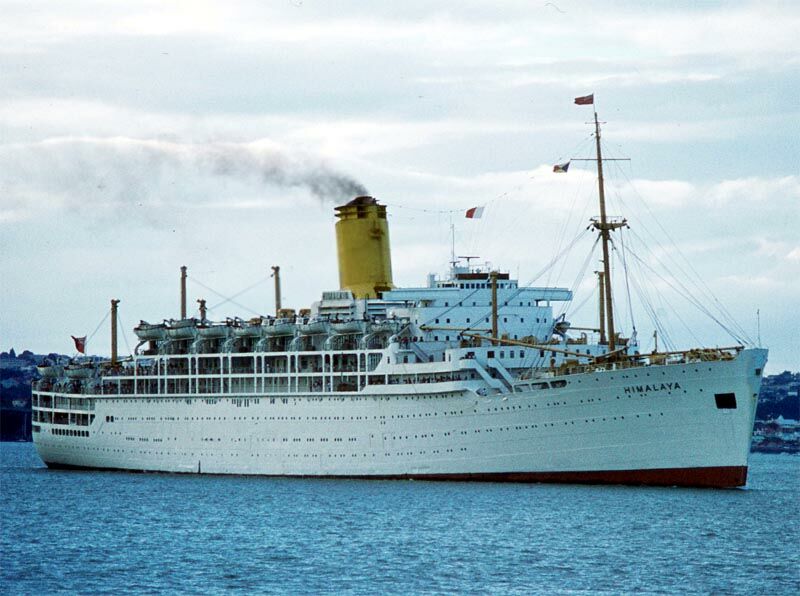
“Himalaya”
is seen arriving in
A VIP Passenger:
In 1956 a VIP passenger joined the “
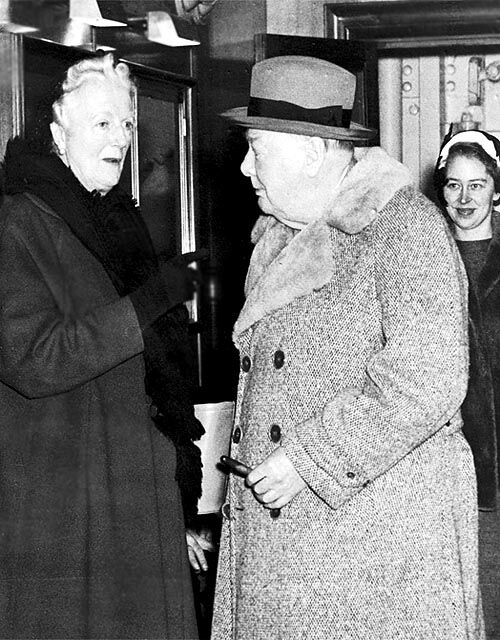
Sir Winston
Churchill saying farewell to his dear wife Lady Clementine aboard the “
Having completed a cruise in August 1956, she was about to depart on her next Voyage to Sydney Australia, which as it turned out was far from being a normal voyage to say the least!
A Sad Voyage:
She departed Tilbury at 1511 hours on August
27, 1956 which
should have been a routine voyage to
when suddenly there was an explosion in a refrigeration unit, located on the starboard side in a working area on E Deck. The blast sadly caused severe burns and injuries and tragically two members of the crew were killed instantly, with another 14 crew members being injured, with a number of these being a critical condition having suffered terrible burns. The ships medical staff did all they were able, and the senior in charge also requested if there were any doctor’s on board, and thankfully there were, and they came and were very helpful.
Thankfully the ship herself was fully
functional and was able to steam full speed ahead and contacted
The “Himalaya” then headed to
She continued her regular voyage and she
arrived at
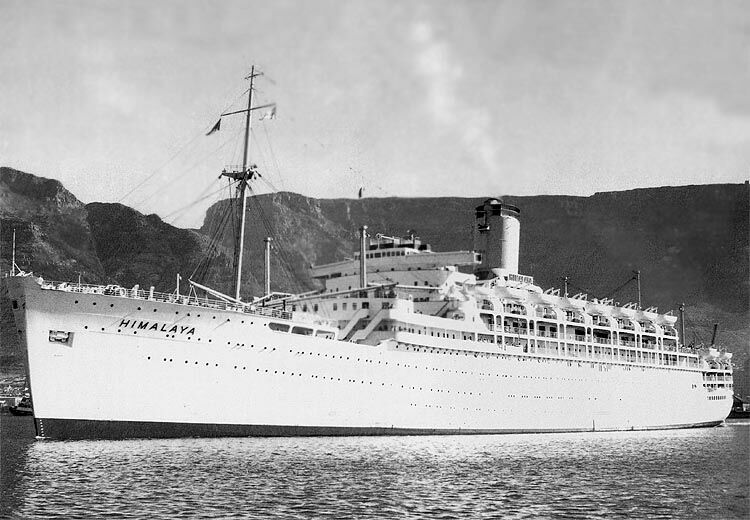
S.S. Himalaya
arriving at
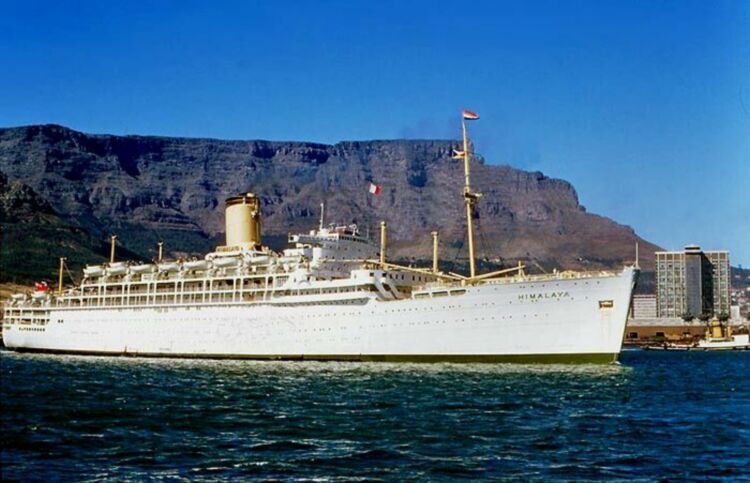
The
“Himalaya” is now seen departing
Image was kindly sent by
Johannes de Vries of
New Around the Word Service:
Some major changes took place in January 1958
when P&O and Orient Line services to
The Himalaya was the first ship to commence
this new around the world service, when she departed
Ports of call for the full around the world service was as follows:
Tilbury (London), Southampton, Le Havre, Lisbon, Gibraltar, Marseilles, Naples, Port Said, Aden, Bombay, Colombo, Penang, Singapore, Fremantle, Adelaide, Melbourne, Hobart, Sydney, Auckland, Suva, Manila, Hong Kong, Kobe, Yokohama, Honolulu, Vancouver, San Francisco, Los Angeles, Panama, Colon, Trinidad, Las Palmas, Madeira, Tilbury.
A Dutch Refit:
During the Northern Hemisphere winter months
of 1959/1960 she was given a major refit at Flushing in the

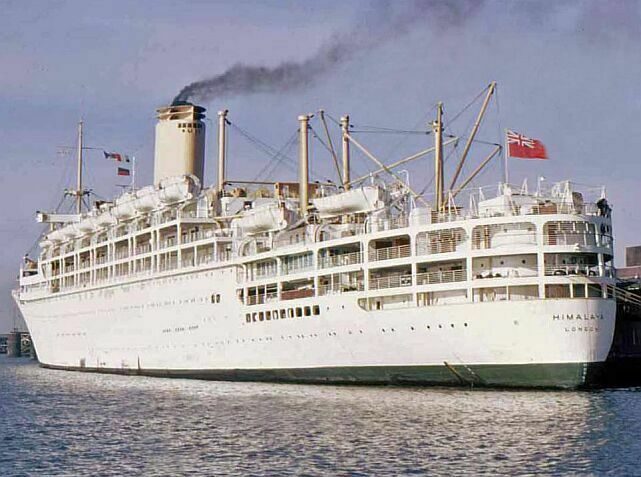
S.S. Himalaya is seen at Tilbury getting ready for her next around the world voyage
Carry on the Himalaya
For passengers on board a voyage in October
1960 it did become a bit like a ‘Carry On’
Movie when they arrived at
It was discovered that a very strange event took place on the ship, for apparently there was a man on board by the name of ‘Stephen Bradley’ who had abducted and murdered an eight year boy who was the son of Australia’s first ever ‘Sydney Opera House lottery’ winner.
Back in
You may have noted that the Himalaya was
returning to the
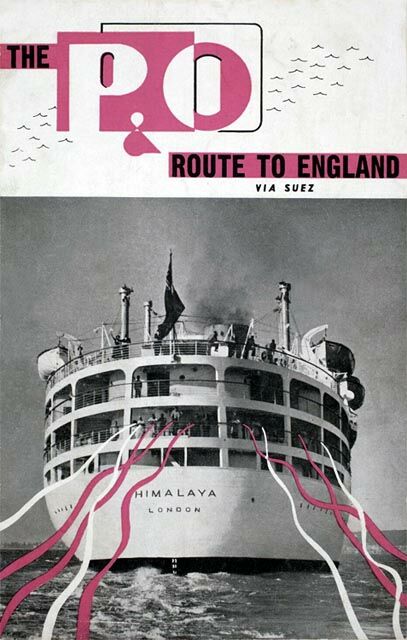
A P&O Australia brochure released in 1960
It’s all Cricket:
Long before the arrival of long-haul air
travel, the Australian Test Match teams would annually travel to
The Australian 1961 Test Team, Captain Richie Benaud and the Vice
Captain Neil Harvey are seen on board the S.S. Himalaya as they and the team
were going to Tilbury for their next big game in the
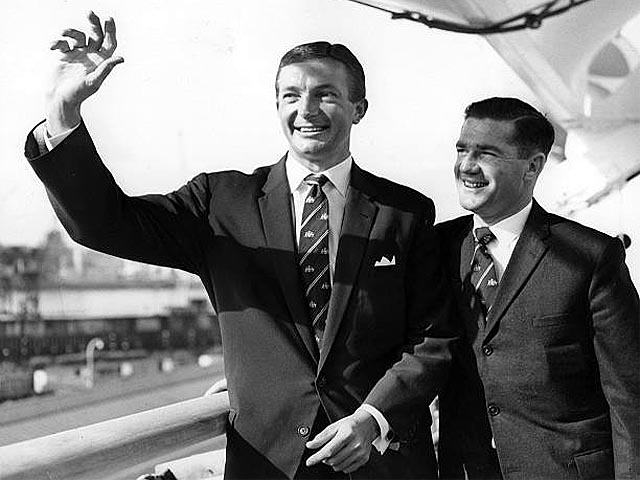
Richie Benaud
and Neil Harvey waving goodbye to their family as the “
The Australian tour party consisted of these players: R Benaud (Captain), R N Harvey (Vice Captain), A T W Grout (wicket keeper), B N Jarman (wicket keeper), W M Lawry, N C O'Neill, P J P Burge, C C McDonald, B C Booth, R B Simpson, K D Mackay, A K Davidson, F M Misson, G D McKenzie, R A Gaunt, I W Quick & L F Kline.
And of course
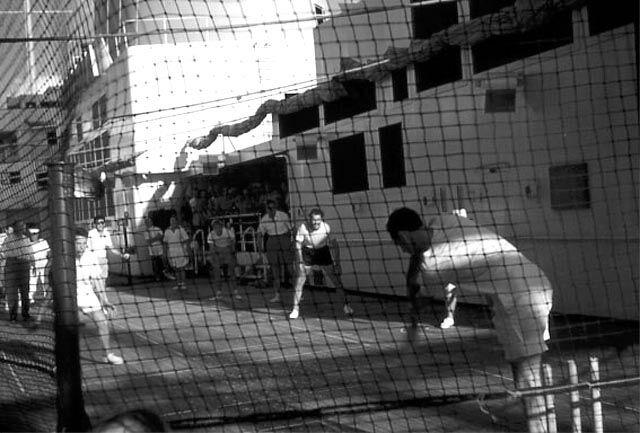
A game of cricket
up on Boat deck
Although there had been other cricket teams on the S.S. Himalaya Long before the arrival of long-haul air travel, the Australian Test Match teams would annually travel to England on board P&O liners, and they did so in March 1956, on the S.S. Himalaya and again in 1961 and both of these tours are shown below.
And here is the Australian 1956 Cricket Test
Team who also sailed on the “
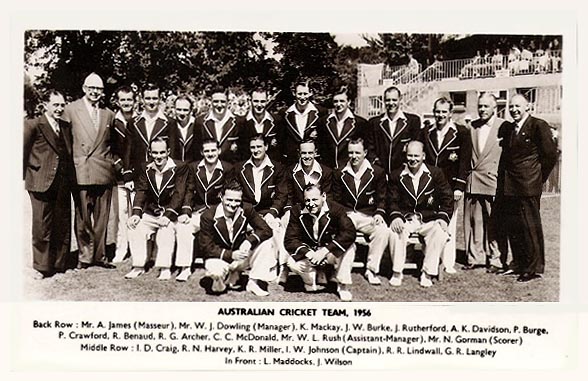
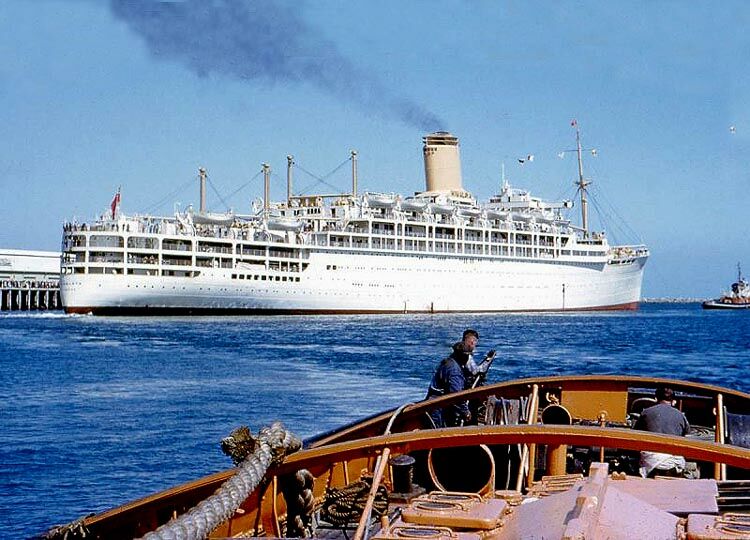
The S.S. Himalaya
is at
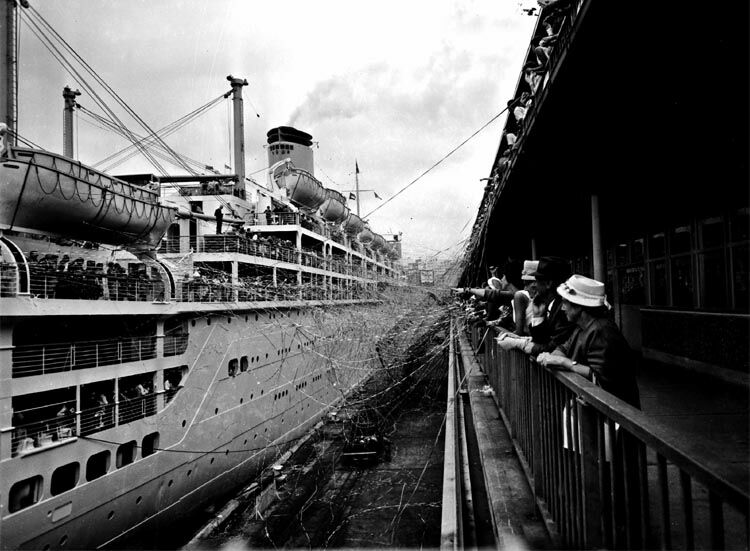
She is about to
set sail and cross the Tasman Sea for Auckland New
and then continue for her long voyage back to
There was something about the
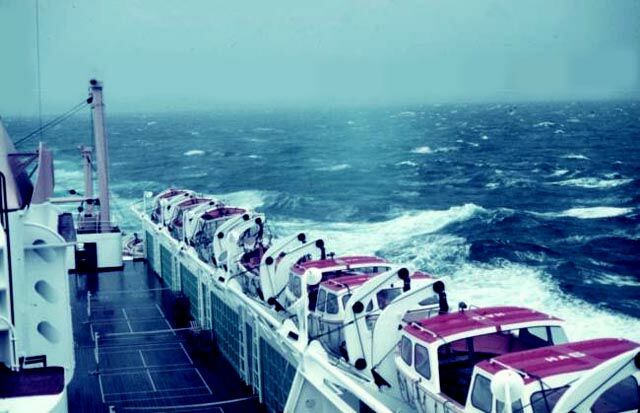
Above &
below: the
For she can get very much worse, and the waves will go right over the top of the ship,
but I did not photograph that, wish I could
These
images were taken by an unknown source
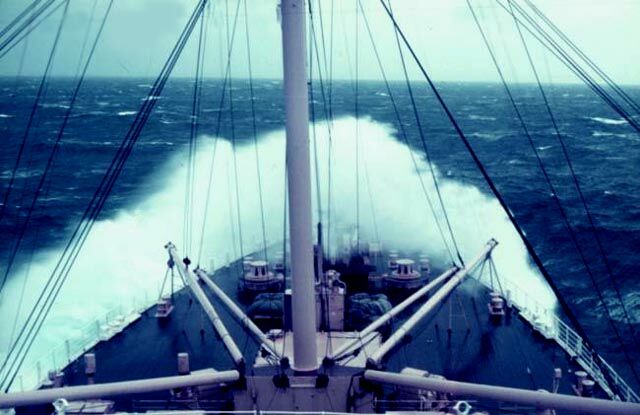
Refitted into a One Class Ship:
On November 8, 1963 she arrived at Tilbury and
she was taken over by ‘R. & H. Green and Silley
Weir Ltd’ as she was due for her annual overhaul, but this time she would
be given an extensive refit as she was
to become a One-Class ship. During the refurbishment the two small lounges
besides the Stairwell forward on Promenade Deck were renamed the ‘Hillary’
and the ‘Tensing’ Rooms. The main First Class Lounge became the
‘Everest Room’ and the old First Class Verandah Café was completely
rebuilt and became on the portside the ‘Overland Bar’, whilst on
the starboard side it became the “Cinema” with seating for 140
persons. Whilst on B Deck the former Tourist Class Ballroom was also split,
with the portside becoming the ‘Yeti Tavern’ complete with a Juke
Box, and the starboard side became the ‘Cascade Room’. Whilst aft on C Deck the
Smoking Room became the ‘Boot & Piton’. The Children’s
Playroom was turned into the aft playground. And finally at the aft end of D
Deck what had been the Tourist Class Lounge became the ‘John Hunt
Room’. The Dining Rooms were renamed as follows, the one located forward
became the ‘Drake Restaurant’ and the aft one became the
‘Tasman Restaurant’. Thus the
In addition to the many changes made, her passenger capacity increased by 280 berths, for passenger numbers rose from 1,136 to 1,416 with some of A Deck’s single bed cabins having a second berth added, whilst two bedded cabins became four berth cabins mostly on B Deck, etc.
Upon completion she was a very attractive One
Class - ‘Tourist Class’ Liner and Cruise Ship, and she would now be
used on both assisted immigrant as well as paying passenger voyages, as well as
operating on occasional vacation cruises from Southampton as well as from
Her New Look Interiors:
Below are several photographs of her new look interiors, the one of the Lounge I happen to have, but the other three I received from a long time reader from the UK, Jonathan Maingard, and I am most thankful to him.
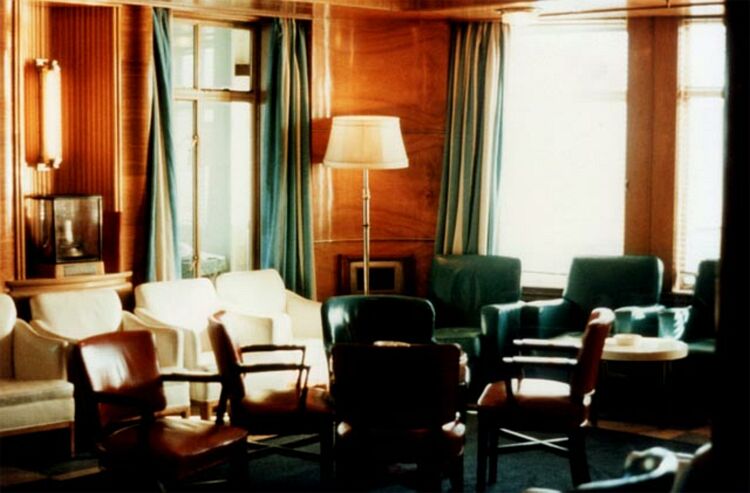
The
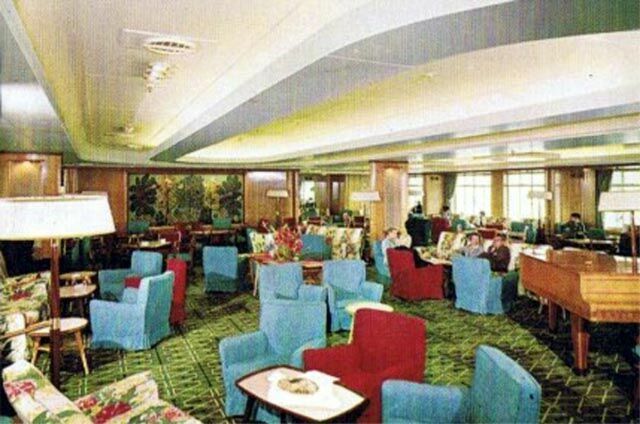
The Lounge
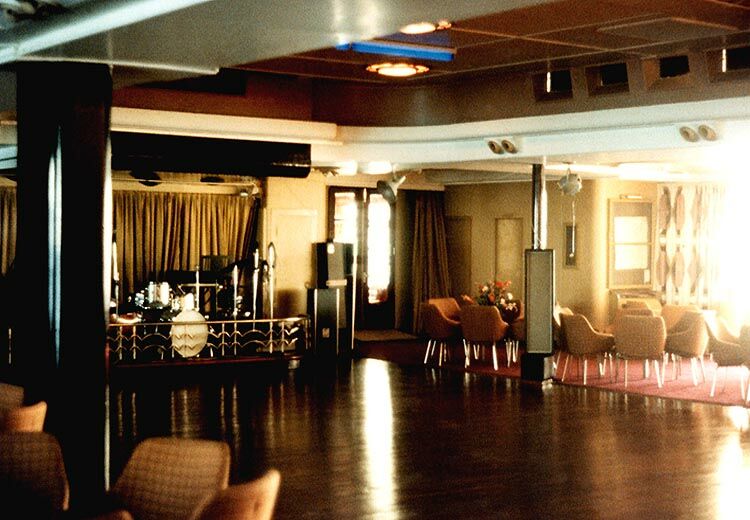
The original First
Class Ballroom
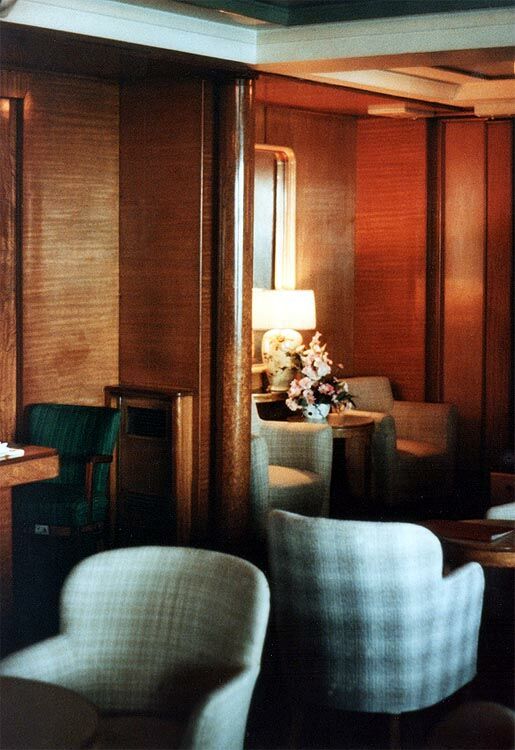
The Library
certainly had a magnificent makeover
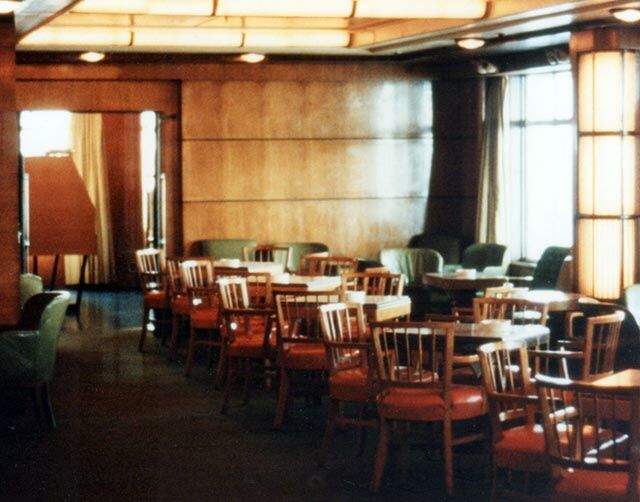
The ex first class
Verandah Café was now the ‘Overland Bar’
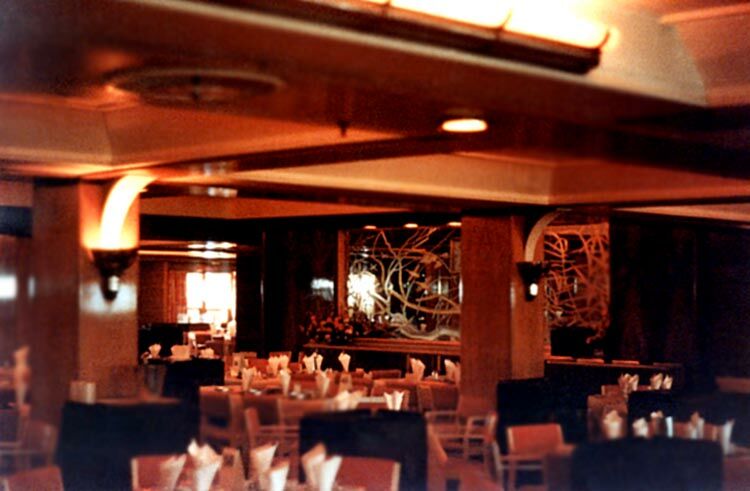
The forward Drake Restaurant
On

The New around the world schedule for 1963 – 1964
For the: S.S.
Canberra, Oriana,
Her new much longer route was as now as follows: London, Rotterdam, Flushing, Southampton, Le Havre, Lisbon, Gibraltar, Barcelona, Marseilles, Naples, Malta, Piraeus, Port Said, Aden, Bombay, Colombo, Penang, Port Swettenham, Singapore, Fremantle, Adelaide, Melbourne, Sydney, Auckland, Wellington, Savu Savu, Suva, Pago Pago, Manila, Hong Kong, Kobe, Yokohama, Honolulu, Vancouver, San Francisco, Los Angeles, San Diego, Acapulco, Panama, Cartagena, Trinidad, Nassau, Port Everglades, Bermuda, London.
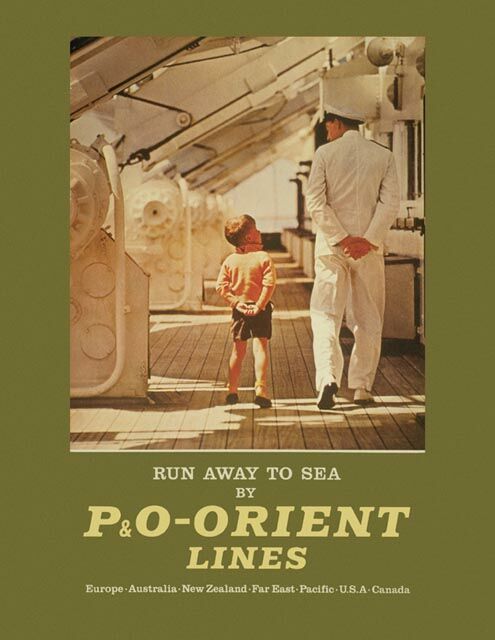
A 1960’s P&O-Orient Lines brochure
Just three years later, in 1966 her management and operation returned once again to P&O Lines.
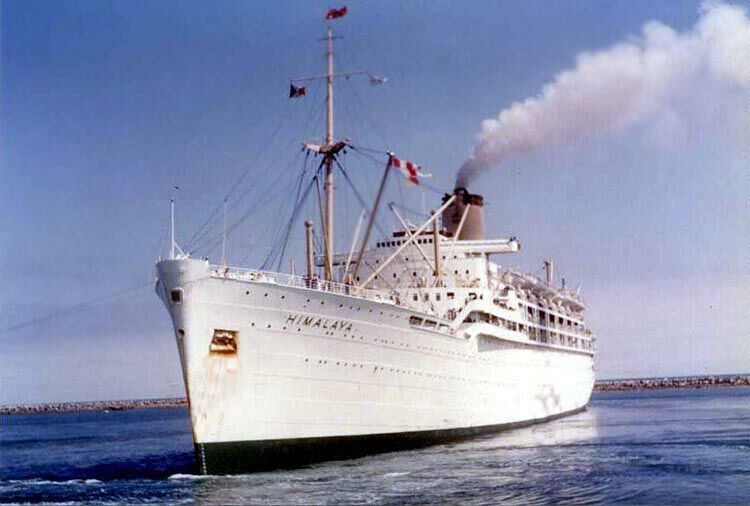
The “Himalaya”
is seen in Port Phillip Bay as she arrived at
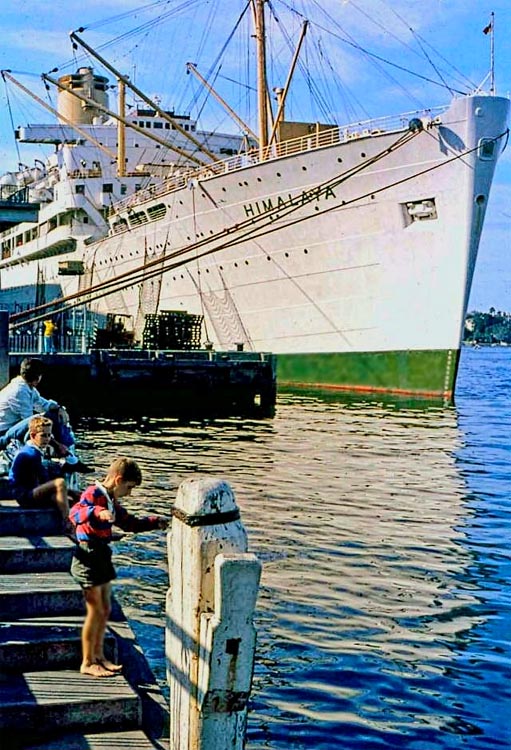
And the S.S.
Himalaya is seen here berthed at
‘Overseas Passengers Terminal’ at Circular Quay
P&O Changes their Base:
On October 10, 1969 the “Himalaya”
departed Tilbury for the final time the reason being was that P&O was
moving their base to
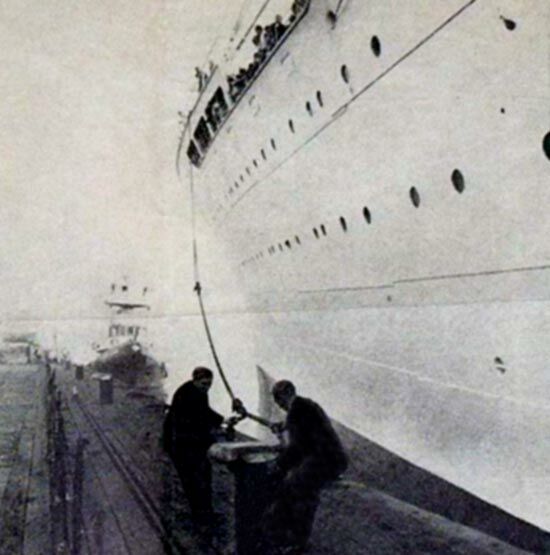
Her departure made all the Newspapers with this image for here we can
see the “
departs Tilbury on October 10, 1969 for the very last time!
S.S. Himalaya the Cruise Ship:
From 1970 the “Himalaya” was
almost exclusively used as a full time cruise ship, and during the Northern Hemisphere
summer (May to October) she would operate cruises from Southampton, and then in September
1970, she would undertake a one way line voyage to
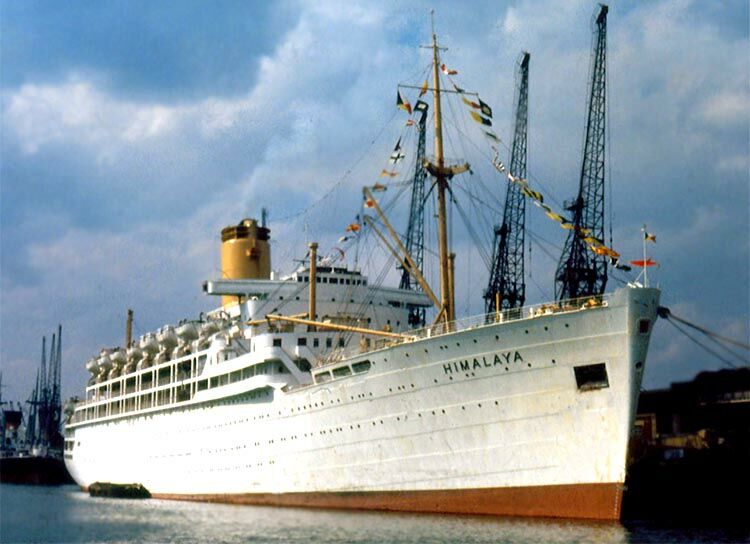
She is due to sail
for
Once she arrived in
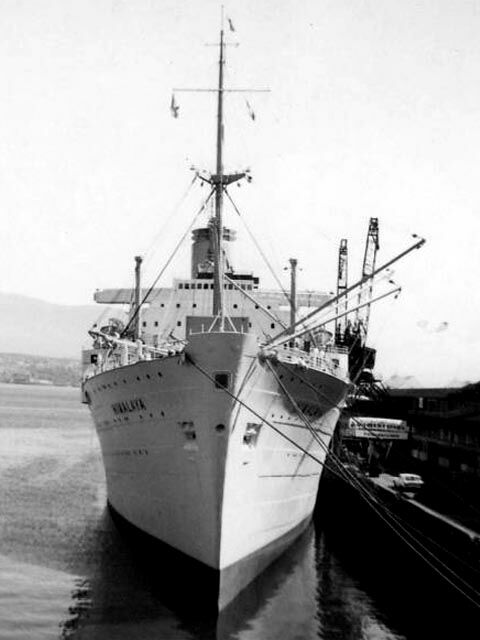
S.S. Himalaya is
seen during 1970’s Cruise services
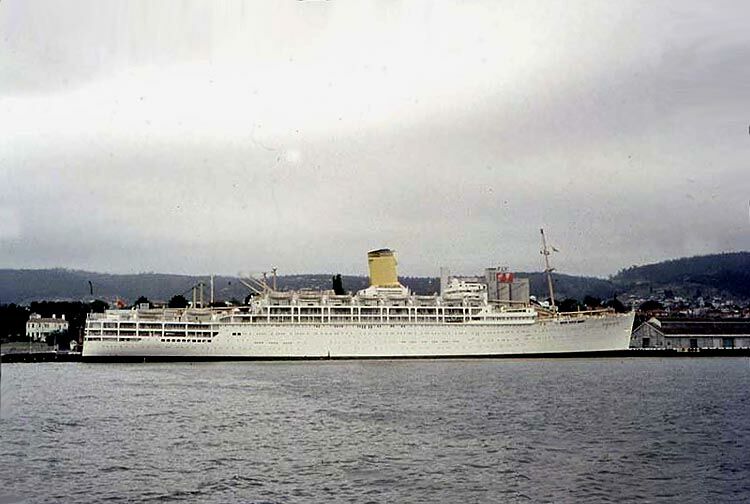
Above &
below: S.S. Himalaya is seen at
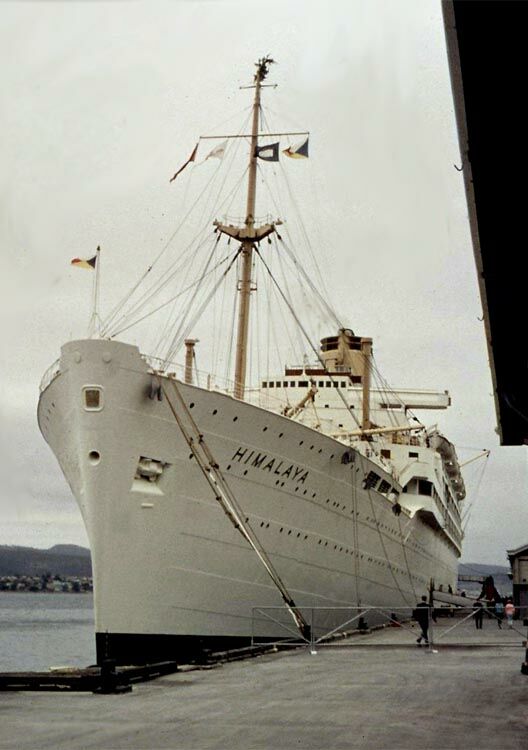
When in
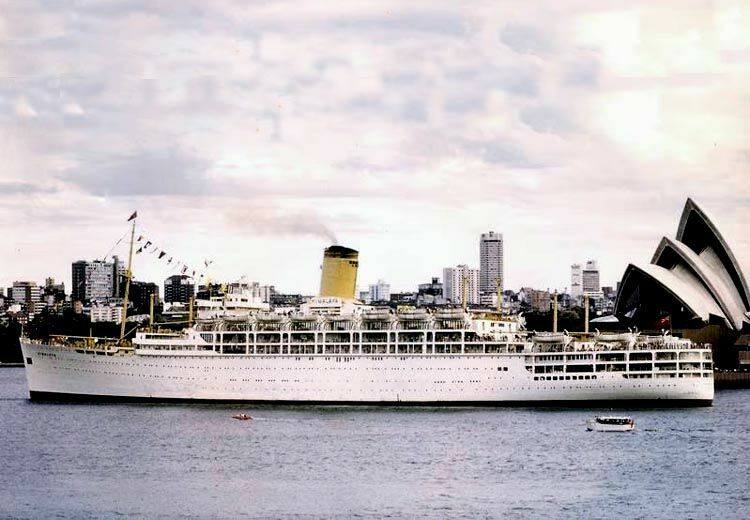
S.S. Himalaya
became an extremely popular cruise ship and she seen here heading off for yet
another cruise
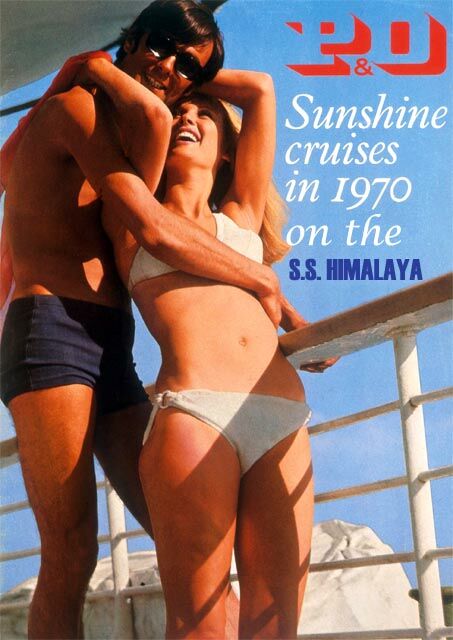
One of the ‘P&O Sunshine Cruise’ series of brochures
In
On
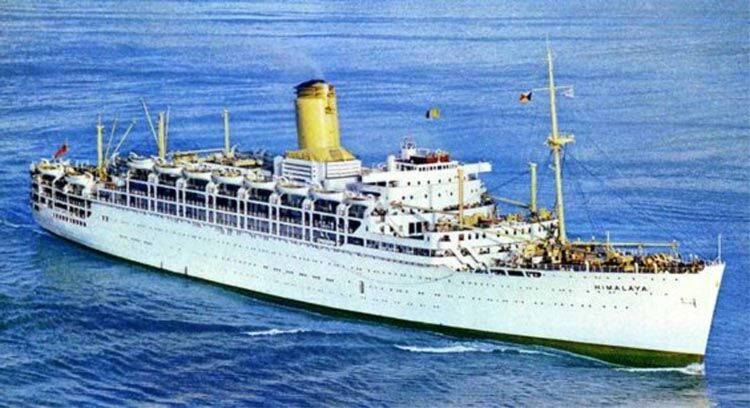
S.S. Himalaya is
seen having just passed through Sydney Heads and is heading for
The “
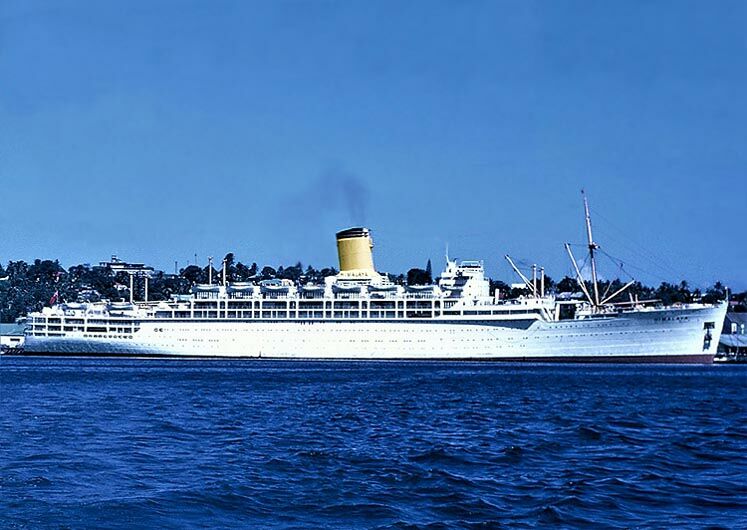
S.S. Himalaya is
seen berthed at
Photograph
provided by Johanes de Weerd
Then, in April 1974 the “Himalaya”
made what was her very last voyage back to Southampton being fully laden with
holiday makers all enjoying an amazing voyage of discovery sailing via the
Pacific, Asia, the
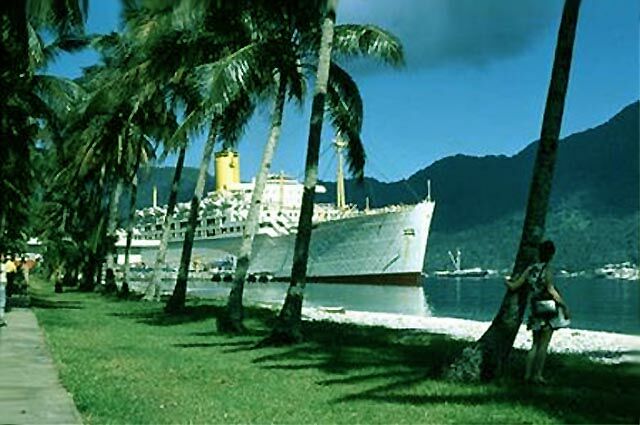
Here she is seen
at ‘
‘
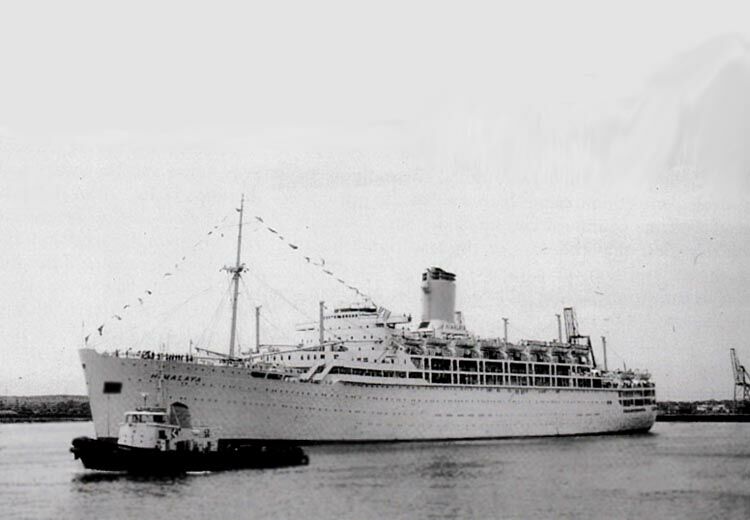
S.S. Himalaya is
seen on the Solent departing on her very last Line Voyage ever from the
For her passengers this voyage proved to be a
very special farewell line voyage and they enjoyed the entire experience
greatly, for as a ship, she was as good as she had always been. Once she
arrived in
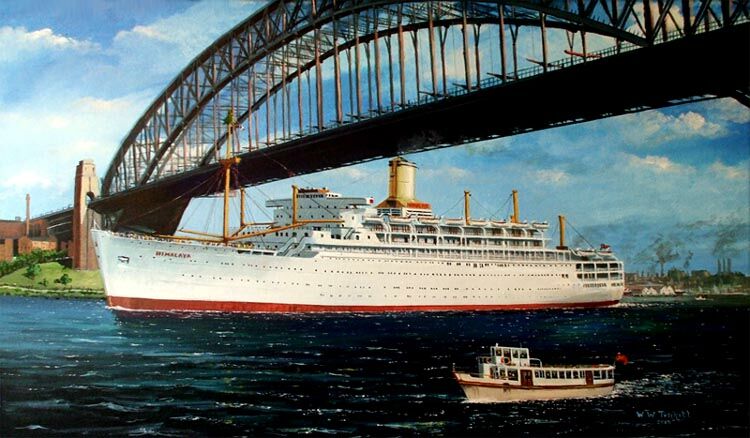
A fine painting of
the S.S. Himalaya in
Artist Wallace Trickett, click the following Link to visit his website - Maritime Paintings
When she arrived back in
She departed
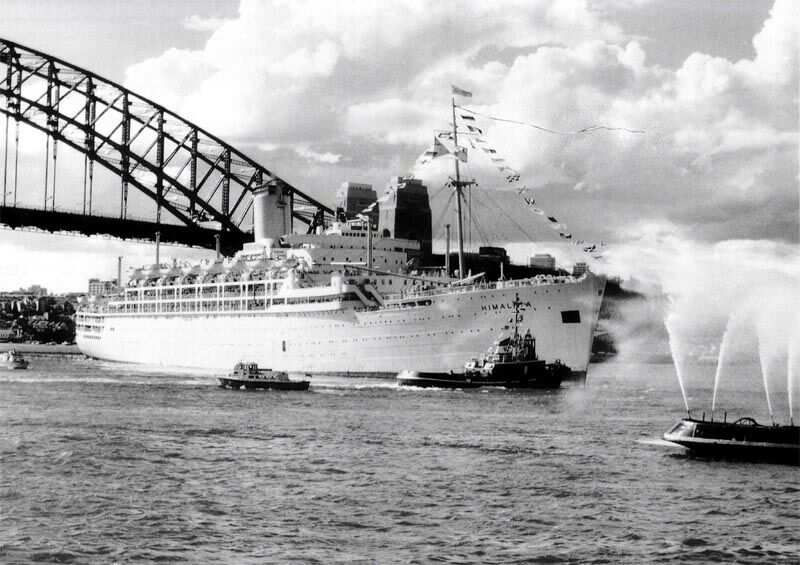
“Himalaya’s” departure from
With the “Himalaya” having
departed
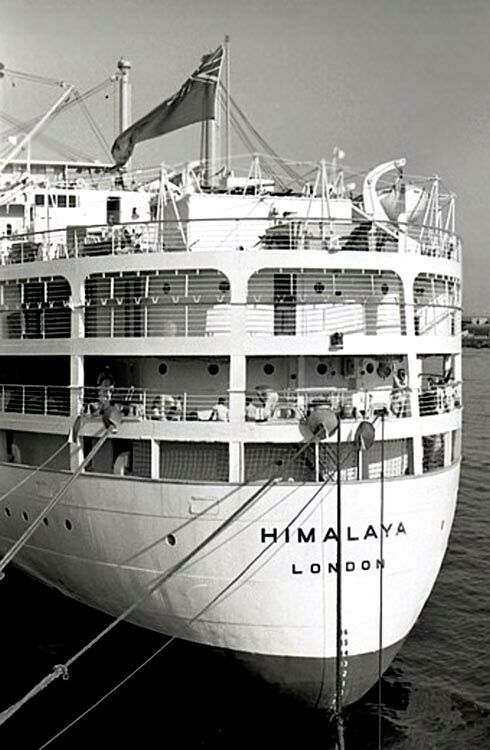
The stern of the “
From here she headed for a rather brief three
hour stop over at
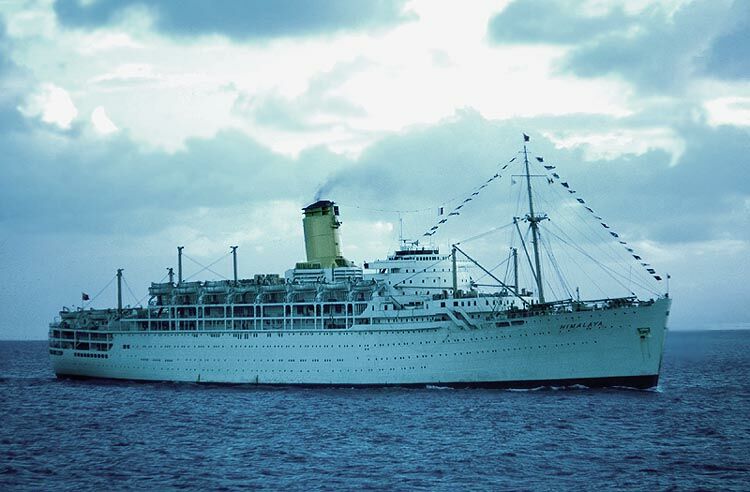
The
“Himalaya” is seen her between
Having sailed majestically up
Soon thereafter much of her fittings were
removed and placed into storage and within four days most of her crew were
signed off and were flown home to the UK and to India, and returned to Goa, as
the Goanese staff would be on vacation until they would be returned for their
next assignment on another ship! Only Captain J. W. Terry and 12 of his
Officers and 26 crew members remained on board and they would take her out of
Hong Kong for her very last ever voyage at 1600 hours on November 26, 1974, and
they headed for
She arrived at the “Tong Cheng Steel
Manufacturing Co. Ltd” breakers yard at 0958 hours on
It is said that S.S. Himalaya during her wonderful 25 year career sailed 2¼ million miles – 3,468,688 kilometres on both line voyages as well as cruises.
Please see the
Index below the next image for “
Also listed are all the other 8 P&O & Orient Line ships I have online.
*********************
Remembering the Delightful …
S.S. Himalaya
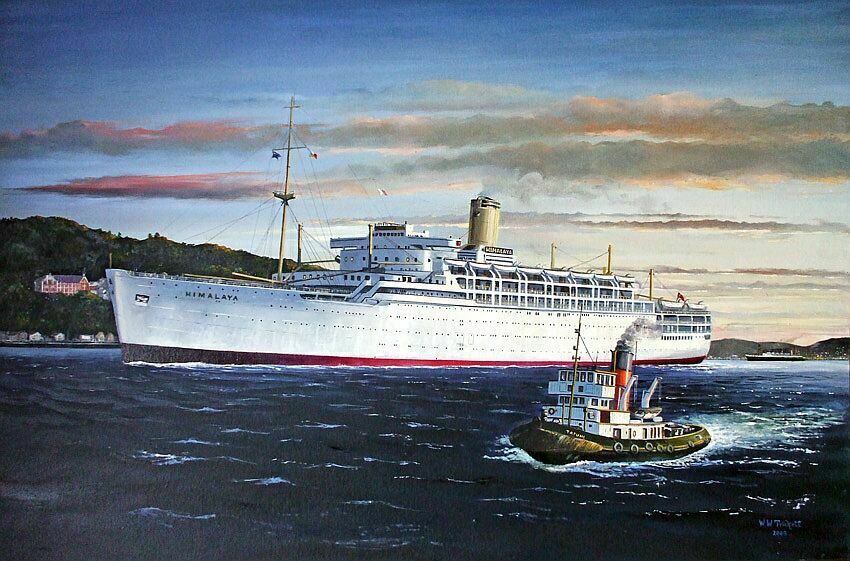
A fine painting of the S.S. Himalaya was painted by the brilliant New Zealand Maritime artist
Wallace Trickett, click the following Link to visit his website - Maritime
Paintings
******************************
The
Go to – Page Two
For her Deck
Plans, Menus and Souvenirs & Memorabilia and her Specifications &
Details.
Two youtube features of the S.S. Himalaya
A
1.21 min clip of her launching on October 5, 1948.
A 5.54 min clip of
a P&O film from the 1960’s featuring the “
a voyage to
Also Visit Features
on the following P&O & Orient Lines Ships
******************************
“Blue Water
Liners sailing to the distant shores.
I watched them come, I watched
them go and I watched them die.”
Featuring well over 1,435 Classic
Passenger Liners, Passenger-Cargo Liners & Classic Cruise Ships!
And since going online we have received an amazing 573.4 million visitors to date
Or ENTER HERE
For interest: Sadly an email service to ssMaritime is no
longer available, due to the author’s old age and chronic illness as well
as being disabled, etc. In the past ssMaritime received well over 120 emails
per day, but
******************************
ssMaritime.com & ssMaritime.net
The Author has been in Passenger Shipping & the Cruise Industry for well over 60 years
In addition he was the founder of “Save the Classic Liners Campaign” in 1990.
Please Note: ssmaritime and associated sites are 100% non-commercial and the
author seeks no funding or favours of any
shape or form, never have and never will!
Photographs on ssmaritime and associate pages are by; the author or from the author’s private collection. In
addition there are some images that have been provided by Shipping Companies
and private photographers or collectors. Credit is given to all contributors.
However, there are some photographs provided to me without details regarding
the photographer/owner concerned.
This notice covers all pages; although, and I have done my best to ensure that all photographs
are duly credited and that this notice is displaced on each page, that is, when
a page is updated!
ssMaritime is owned
& © Copyright by

